#fundamentals of expressive character design
Text

Kabru is such a brilliantly written character, one of the best in Dungeon Meshi (which is a high bar as it is, most of the main cast are similarly genius).
His thing is that he is very friendly and nice confident and maxed out his charisma stat, but is also kinda ambitious and manipulative. But not in an overtly malicious way. Which kinda scares me.
The most impressive thing about him, writing wise, is that it’s all show-don’t-tell. He very frequently uses his charm and empathy and understanding of how people think in really clever ways. We’re often walked through his thought process of how he does these social deductions. We’re never told he’s scarily charismatic, besides other characters reacting to him being scarily charismatic.
Kabru is a natural-born leader and social engineer with superlative skills in both, which makes him the perfect foil for Laios, who’s too autistic and unambitious that he’s not even the de facto leader of his own party that he’s the official leader of. He’s so bad at leadership that his party just, sort of, doesn’t have a leader. They just kinda argue and do stuff.
What’s also neat, and perfectly inline with Meshi’s general theme of clever and logical subversions of fantasy tropes, is that Kabru’s character design in no way clues us in on this fundamental character trait of his.
He’s sort of a human fighter / knight archetype, which in the language of fantasy RPGs is a class most would associate with being a white bread jock, chivalrousness optional. (Laios subverts the same trope in the same way. It’s really funny that the walking exposition dump of the group looks like the character creator default preset spec’d as the most generic class available.)
If Kabru was a bard or noble and Laios a wizard, their character traits would be far less interesting
Even better is that we would expect someone who looks like Laios to have Kabru’s personality, and vice versa. Their character designs are flipped; the confident super charismatic leader is a short wide-eyed twink, while the slightly naive and very autistic monster enthusiast is a tall conventionally attractive Aryan lookin’ mf. (see what I mean by Kabru being such a good foil for Laios?? No wonder everyone ships them, they’re perfect for each other!)

Yet, their designs also work for them. Kabru just has a face that’s easy to talk to, his piercing blue eyes and curly hair gives him a false sense of naïveté, while his iconic 👁️👁️ expression hints that there’s actually quite a bit going on inside his head. Meanwhile, Laios believably looks like someone who doesn’t know what hair conditioner is. His armor’s collar gorget thing is also pretty dorky.
You can’t trust people like that (I mean overly charismatic people with a manipulative streak, not blue-eyed twinks) because you can’t know what their real motives are. You can’t know they aren’t pretending, you can’t know they aren’t trying to or haven’t already manipulated you. How could you? When he has so much more social intelligence than you do, average socially awkward Tumblr user? He’s touched all the grass!
In episode 16 (spoilers, btw) Kabru finally meets Laios’s party, who he’s been trying to find and fight for the better part of the season, and he just decides that no confrontation is necessary. Like, immediately upon meeting the guy. Just from how Laios looked at him. He figures that since Laios didn’t seem to recognize him, they either have never met meaning he has the wrong guy, or Laios forgot meaning he didn’t think it’d be a big deal, meaning the treasure was a trap or something. Which is pretty in line with Kabru’s established ability to always roll nat 20s for every charisma and deductive reasoning check, so cool.
But he doesn’t even seem curious about which of those cases is true. (He might be interested to find out some of the treasure wasn’t dangerous, but accidentally got thrown off a bridge). Much to Rin’s dismay, he’d rather just not bring it up because that could upset the leader of the party he might be working with for the foreseeable future.

Actions speak louder than words. So, all we really learn in this scene is that Kabru’s goals and M.O. can change on a dime, and that he values reputation and political capital more than money and vengeance. More than his own party’s desire for those things. Not only is he someone with a silver tongue, but he knows its value and is determined to use it at every opportunity.
Kabru and his party might not be very good at fighting or surviving in the dungeon, in fact their frequent TPKs are a running gag. But, he also doesn’t need to be when he can just manipulate Laios’ and Shuro’s much more proficient parties into helping him.
So far, Kabru seems like the most likely one to become king of the dungeon or whatever the mcguffin is. He is the only protagonist so far who has said that’s an actual goal of his. He’s said that he doesn’t think someone like Laios who isn’t a born leader should get it.
In fact, Kabru seems to have very strong opinions on what kinds of people should be allowed to adventure in the dungeon, evidenced by the fact that he murdered an entire party over it, justified or not. Kabru seems to think that Kabru is such a leader, and he’s probably right about that, but what kind of leader?
What would Kabru do with that kind of power if he gets it? Because I’m not sure. All I know is that he is the kind of person with the ability to use real political power to its full potential. For good, or for very, very bad.
I’m not saying that Kabru is evil or that he’s secretly gonna be the surprise villain. I dunno, I haven’t read the manga. He could just be a nice guy that’s just, like, is like that. Everything he’s done could be justified by the explanations he’s given. He actually reminds me a lot of one of my IRL friends, and I’d trust him with my life.
But, I can’t help but feel a distinct sense of unease whenever he’s on-screen. I try not to trust confident natural-born leaders like him right out of the gate. I don’t like that our instinct as humans is to blindly follow them without thinking about it.
Tyrants and psychopaths also use confidence and charm and a friendly demeanor to make people think they’re a good guy, while manipulating everyone into thinking their self-serving actions are altruistic. Benevolent, confident, skilled leaders do exist. But there exists many more snakes wearing their skin. Wolves rarely bother with sheep’s clothing, they dress as shepherds and sheepdogs.
Anyway, my point is that I think it’s kinda neat that it’s possible to overthink this much about a character whose probably just a nice guy that is the mirror opposite of an autistic person. Writing that kind of ambiguity is hard, and employing it in this way is inspired.
195 notes
·
View notes
Text
I busted out this whole course in like a week and then didn't upload any of it lol. Anyway, this is work from the second half of Woulter Tulp's Fundamentals of Expressive Character Design course on Schoolism. In the first half, the focus was on dynamic, fluid shapes. This half was about proper perspective and 3D rotations. Let me tell you, this just about broke my brain. There is also some expression work at the bottom which I have historically struggled with. After all these years of drawing, it's interesting how these fundamentals kick my butt.
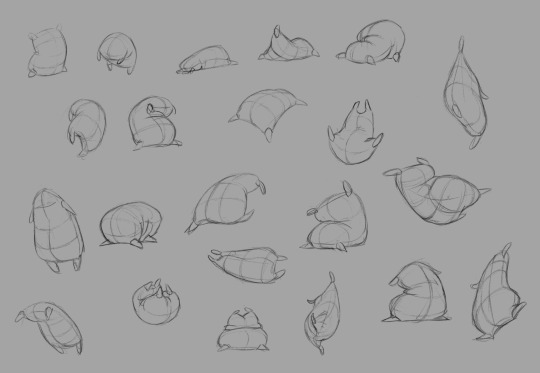
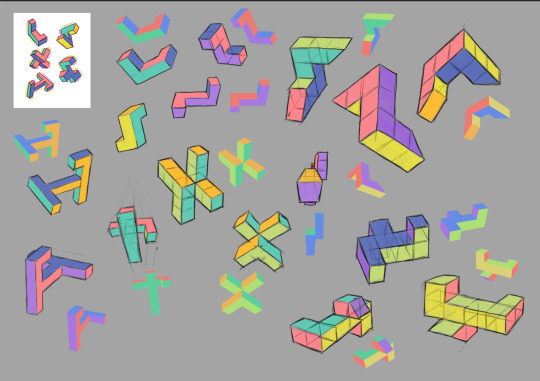

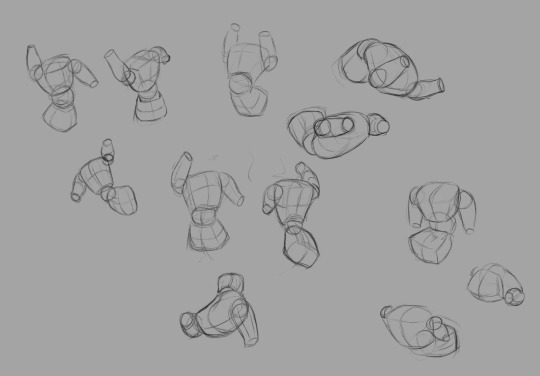



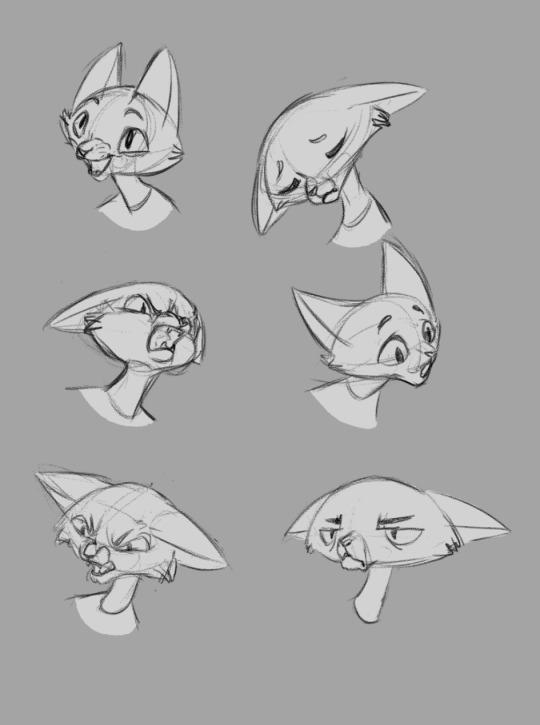
#woulter tulp#schoolism#schoolism course#photoshop#artist on tumblr#studies#sketches#dynamic#fundamentals of expressive character design#fundamentals#my brain :')
1 note
·
View note
Text

hotel manager
#zeno's art#i'm not sure if i should tag the show itself as i'm not a fan but i guess its “fan”art so i will#hazbin hotel#charlie hazbin hotel#vivziepop#i was bored and wanted to draw something#my main goal here was to create a design that looked distinct and could (potentially) be moderately easy to animate#of course based on charlie's character i added as many angel images as possible through the hair and bowtie#(i know white on white is a character design sin but i wanted to show the angel wing detail ;w;)#also to express the personality and juxtaposition of a sweet devil her horns are supposed to curve into a heart shape#of course the garterbelts are upside-down/st peters crosses because of her satanic themes#i also tried to go harder into the goat theme but its still subtle i think#i actually think the goat theme is really interesting because of the story of the sheep and the goats in the bible#but i cant remember if it was actually something intended in her original design#i'm not going to draw anyone else so dont even anticipate that#this was basically a cooldown? ok i think i'm rambling now#goodbye#ok edit to say it clearly: i am not a fan of vivziepop or her work. i just wanted to redesign charlie as a cooldown/exercise for fun#because i used to be a fan of the character before i wised up about what vivzie had and has done#and before i matured and noticed the cracks and fundamental flaws in her works#so yea i dont support her at all and this redesign is critical i guess#also the reason why the tag “vivziepop” is there in the first place is so that anyone who has that tag silenced can scroll past#without seeing anything related to her work. in case that clears anything up#its the same reason why i tag “long post” and “food” and the like
672 notes
·
View notes
Text
TUMBLR POST EDITOR WON'T LET ME TITLE THIS POST ANYMORE SO I GUESS THIS IS THE TITLE NOW. WEBBED SITE INNIT
So let's say you grew up in the nineties and that The Lion King was an important movie to you. Let's say that the character of Scar - snarling, ambitious, condescending, effeminate Scar - stirred feelings in you which you had no words for as a child. And then let's say, many years later, you're talking about it with a college friend, and you say something like, "oh man, I think Scar was some sort of gay awakening for me," and she fixes you with this level stare and says, "Scar was a fascist. What's the matter with you?"

The immediate feeling is not unlike missing a step: hang on, what's happening, what did I miss? You knew there were goose-stepping hyenas in "Be Prepared," but you didn't think it mattered that much. He's the bad guy, after all, and the movie's just pointing it out. Your friend says it's more than that: the visuals of the song are directly referencing the Nuremberg rallies. They're practically an homage to Riefenstahl. This was your sexual awakening? Is this why you're so into peaked caps and leather, then? Subliminal nazi kink, perhaps?
And then one of your other friends cuts in. "Hold up," he says, "let's think about what Scar actually did in the movie. He organized a group of racialized outcasts and led them against a predatory monarchy. Why are you so keen to defend their hereditary rule? Scar's the good guy here." The conversation immediately descends into a verbal slap fight about who the real bad guy is, whether Scar's regime was actually responsible for the ecological devastation of the Pride Lands, whether the hyenas actually count as "racialized" because James Earl Jones voiced Mufasa after all. Your Catholic friend starts saying some strange and frankly concerning shit about Natural Law. Someone brings The Lion King 2 into it. You leave the conversation feeling a little bit lost and a little bit anxious. What were we even talking about?
INTRODUCING: THE DITCH
There is a way of reading texts which I'm afraid is pervasive, which has as its most classical expression the smug obsession with trivia and minutiae you find in a certain vein of comic book fan. "Who was the first Green Lantern? What was his weakness? Do you even know the Green Lantern Oath?" It eschews the subjective in favor of definitively knowable fact. You can't argue with this guy that, say, Alan Scott shouldn't really count as the first Green Lantern because his whole deal is so radically different from the Hal Jordan/John Stewart/Guy Gardner Corps-era Lanterns, because this guy will simply say "but he's called Green Lantern. Says so right on the cover. Checkmate." This approach to reading a text is fundamentally 1) emotionally detached (there's a reason the joke goes, oh you like X band? name three of their songs - and not, which of their songs means the most to you? which of them came into your life at exactly the right moment to tell you exactly what you needed to hear just then?) and 2) defensive. It's a stance that is designed not to lose arguments. It says so right on the cover. Checkmate.
And then you get the guys who are like "well obviously Bruce Wayne could do far more as a billionaire to solve societal problems by using his tremendous wealth to address systemic issues instead of dressing up as a bat and punching mental patients in the head," and these guys have half a point but they're basically in the same ditch butting heads with the "well, actually" guys, and can we not simply extricate ourselves from the ditch entirely?
So, okay, let's return to our initial example. Scar is portrayed using Nazi iconography - the goose-stepping, the monumentality, the Nuremberg Lichtdom. He is also flamboyant and effete. He unifies and leads a group of downtrodden exiles to overthrow an absolute monarch. He's also a self-serving despot on whose rule Heaven Itself turns its back. You can't reconcile these things from within the ditch - or if you can, the attempt is likely to be ad-hoc supposition and duct tape.
Instead, let's ask ourselves what perspective The Lion King is coming from. What does it say is true about the world? What are its precepts, its axioms?
There is a natural hierarchical order to the world. This is just and righteous and the way of things, and attempts to overthrow this order will be punished severely by the world itself.
Fascism is what happens when evil men attempt to usurp this natural order with the aid of a group or groups of people who refuse to accept their place in the order.
There exists an alternative to defending and adhering to one's place in the natural order - it consists only of selfish spineless apathy.
Manliness is an essential quality of a just ruler. Unmanliness renders a person unfit for rule, and often resentful and dangerous as well.
And isn't that interesting, laid out like that? It renders the entire argument about the movie irrelevant (except for whatever your Catholic friend was on about, since his understanding of the world seems to line up with the above precepts weirdly well.) It's meaningless to argue about whether Scar was a secret hero or a fascist, when the movie doesn't understand fascism and has a damn-near alien view of what good and evil are.
There's always gonna be someone who, having read this far, wants to reply, "so, what? The Lion King is a bad movie and the people who made it were homophobes and also American monarchists, somehow? And anyone who likes it is also some sort of gay-bashing crypto-authoritarian?" To which I have to reply, man, c'mon, get out of the ditch. You're no good to anyone in there. Take my hand. I'm going to pull on three. One... two...
SO PHYREXIA [PAUSE FOR APPLAUSE, GROANS]
We're talking about everyone's favorite ichor-drooling surgery monsters again because there was a bit in my ~*~seminal~*~ essay Transformation, Horror, Eros, Phyrexia which seemed to give a number of readers quite a bit of trouble: namely, the idea that while Phyrexia is textually fascist, their aesthetic is incompatible with real-world fascism, and further, that this aesthetic incompatibility in some way outweighs the ways in which they act like a fascist nation in terms of how we think of them. I'll take responsibility here: I don't think that point is at all clear or well-argued in that essay. What I was trying to articulate was that the text of Magic: the Gathering very much wants Phyrexia to be supremely evil and dangerous fascists, because that makes for effective antagonists, but in the process of constructing that, it's accidentally encoded a whole bunch of fascinating presuppositions that end up working at cross-purposes with its apparent aim. That's... not that much clearer, is it? Hmm. Why don't I just show you what I mean?
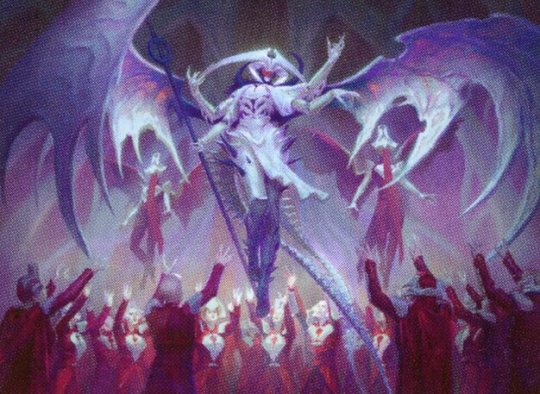
Atraxa, Grand Unifier (art by Marta Nael)
In "Beneath Eyes Unblinking," one of the March of the Machine stories by K. Arsenault Rivera, there's a fascinating and I think revealing passage in which Atraxa (big-deal Phyrexianized angel and Elesh Norn's lieutenant) has a run-in with an art museum in New Capenna. The first thing I want to talk about is that, in this passage, Atraxa has no understanding of the concept of "beauty". A great deal of space in such a rushed storyline is devoted to her trying to puzzle out what beauty means and interrogating the minds of her recently-compleated Capennan aesthetes to try and understand it. In the end, she is unable to conceive of beauty except as "wrongness," as anathema.
So my first question is, why doesn't Atraxa have any idea of beauty? This is nonsense, right? We could point to a previous story, "A Garden of Flesh," by Lora Gray, in which Elesh Norn explicitly thinks in terms of beauty, but that's a little bit ditchbound, isn't it? The better argument is to simply look at Phyrexian bodies, at the Phyrexian landscape, all of which looks the way it does on purpose, all of which has been shaped in accordance with the very real aesthetic preferences of Phyrexians. How you could look at the Fair Basilica and not understand that Phyrexians most definitely have an idea of beauty, even if you personally disagree with it, is baffling. This is a lot like the canonical assertion that Phyrexians lack souls, which is both contradicted elsewhere in canon and essentially meaningless, given Magic's unwillingness or inability to articulate what a soul is in its setting, and as with this, it seems the goal is simply to dehumanize Phyrexians, to render them alien, even at the cost of incoherence or internal contradiction.
Atraxa's progress through the museum is fascinating. It evokes the 1937 Nazi exhibit on "degenerate art" in Munich, but not at all cleanly. The first exhibit, which is of representational art, she angrily destroys for being too individualistic (a point of dissonance with the European fascist movements of the 20th century, which formed in direct antagonism to communism.) The second exhibit, filled with abstract paintings and sculptures, she destroys even more angrily for having no conceivable use (this is much more in line with the Nazi idea of "degenerate art", so well done there.) The third exhibit is filled with war trophies and reconstructions from a failed Phyrexian invasion of Capenna many years prior, which she is angriest of all with (and fair enough, I suppose.) But then, after she's done completely trashing the place, she spots a number of angel statues on the cathedral across the plaza, and she goes apeshit. In a fugue of white-hot rage, she pulverizes the angel heads, and here is where I have to ask my second question:
Why angels? If you are trying to invoke fascist attitudes toward art, big statues of angels are precisely the wrong thing for your fascist analogues to hate. Fascists love monumental, heroic representations of superhuman perfection. It's practically their whole aesthetic deal. I understand that we're foreshadowing the imminent defeat of Phyrexia at the hands of legions of angels and a multiversal proliferation of angel juice, but that just leads to the exact same question: why angels? To the best of my knowledge, the Phyrexian weakness to New Capennan angel juice is something invented for this storyline. They have, after all, been happily compleating angels since 1997. We could talk about the in-universe justification for why Halo specifically is so potent, but I don't remember what that justification is, and also don't care. Let's not jump back in the ditch, please. The point is, someone decided that this time, Phyrexia would be defeated by an angelic host, and what does that mean? What is the text trying to say? What are its precepts and axioms?
Let me ask you a question: how many physically disabled angels are there in Magic: the Gathering? How about transsexual angels? How many angels are there, on all of the cards that have ever been printed for Magic: the Gathering, that are even just a bit ugly? Do you get it yet? Or do you need me to spell it out for you?
SPELLING IT OUT FOR YOU
There is a kind of body which is bad. It is bad because it has been significantly altered from its natural state, and it is bad because it is repellent to our aesthetic sensibilities.
The bad kind of body is contagious. It spreads through contact. Sometimes people we love are infected, and then they become the bad kind of body too.
There is a kind of body which is good. It is good because it is pleasing to our aesthetic sensibilities, and it is good because it is unaltered from its (super)natural state.
A happy ending is when all the good bodies destroy or drive into hiding all of the bad bodies. A happy ending is when the bad bodies of the people we love are forcibly returned to being the good kind of body.
Do you get it now?
ENDNOTES
It's worth noting that the ditch is very similar to the white American Evangelical hermeneutics of "the Bible says it. I believe it. That settles it," the defensive chapter-and-verse-or-it-didn't-happen approach to reading a text, what Fred Clark of slacktivist calls "concordance-ism". I don't think that's accidental. We stand underneath centuries of people reading the Bible very poorly - how could that not affect how we read things today? We are participants in history whether we like it or not.
I sincerely hope I haven't come across as condescending in this essay. Close reading is legitimately difficult! They teach college courses on this stuff! And while it is frustrating to have my close readings interrogated by people who... aren't doing that, like. I do get it. I find myself back in the ditch all the time. This stuff is hard. It is also, sorry, crucial if you intend to say something about a text that's worth saying.
I also hope I've communicated clearly here. Magic story is sufficiently incoherent that trying to develop a thesis about it often feels like trying to nail jello to the wall. If anyone has questions, please ask them! And thank you for reading. Next time, we'll probably do the new Eldraine set.
#phyrexia#not defining the ditch except by implication#thanks to all the very smart vorthoi on the flavor text discord server for helping me work through my thoughts on fascism and phyrexia#this is technically the march of the machine review also#or as much of one as i care to do
5K notes
·
View notes
Text
Something that I've noticed ever since the Smiling Critters were introduced is that they can so easily be paired off into complementary duos, ones that are specifically designed to teach children fundamental lessons about life and self-care from two different angles. It's really interesting to me.
Like obviously you have Dogday and Catnap, with their sun/moon, dog/cat dichotomy, that stress how important it is to have fun and get things done during the day, but also that it's important to wind down, relax, and get a good night's sleep.
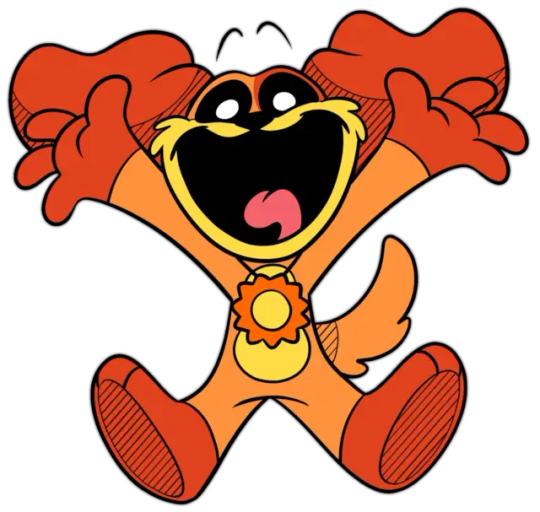
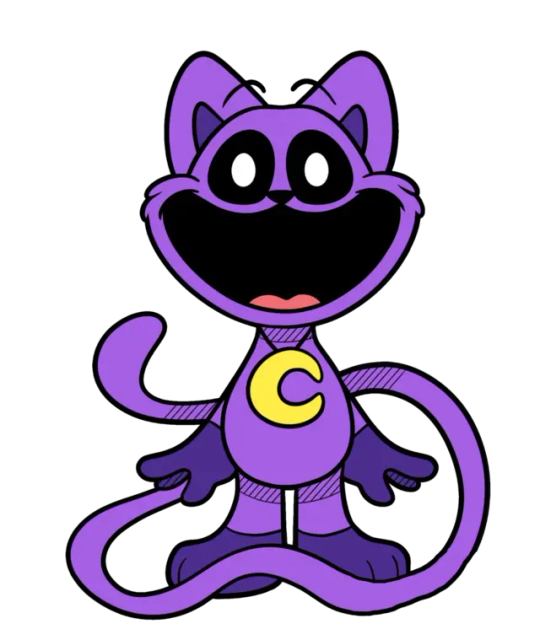
-
Bubba Bubbaphant and Craftycorn were introduced as a duo in the Smiling Critter show's intro, and their dichotomy is quite obvious. They are basically the right and left sides of the brain personified. Bubba is the left side of the brain, logical, analytical, focused on math and science. Craftycorn is the right side of the brain, creative and imaginative, focused on the arts and self-expression. They represent learning and academia in all its forms, the different ways people engage with and understand the world.
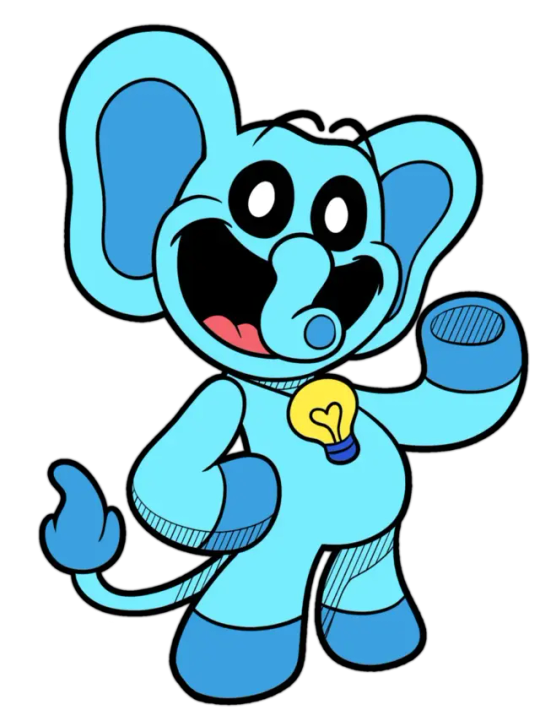
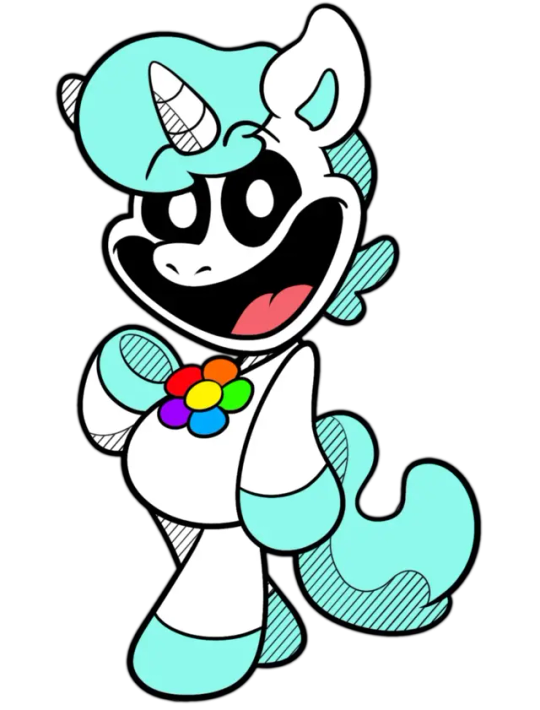
-
Hoppy Hopscotch and Kickin' Chicken form the sportsmanship duo. They are both portrayed as enjoying sports and the outdoors, but in different ways that highlight the different ways sports can be played and enjoyed and also what it entails to be successful at them. Hoppy Hopscotch may be loud and impatient, but she is also a team player, shown in her willingness to slow down her fast pace to make sure none of her friends are left behind. Kickin' Chicken, on the other hand, is laid-back, relaxed, and chill, the described "cool kid" of the group, but he's also described as having a ton of perseverance, more of a "slow and steady wins the race" type of person.
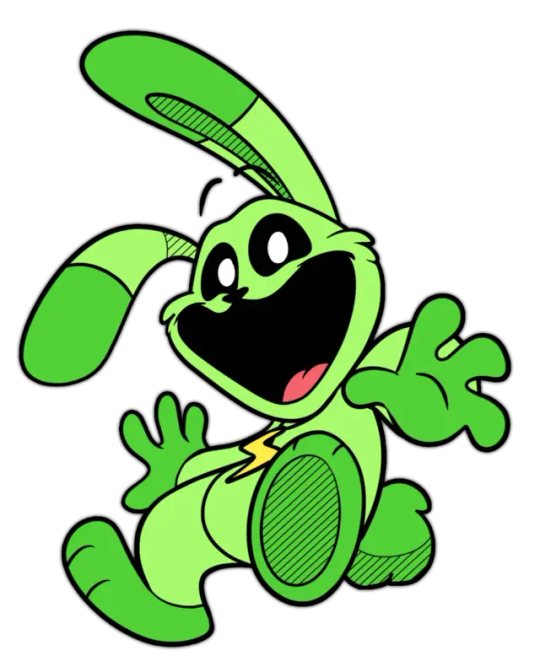
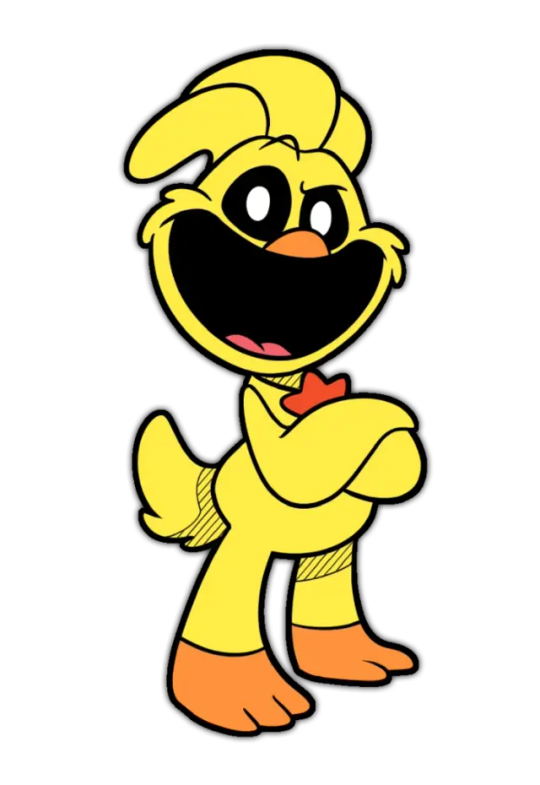
-
This leaves Bobby Bearhug and Picky Piggy as the last pair. Fittingly, these two are all about how to meet the fundamental needs of yourself and others. Bobby teaches children how to nourish themselves emotionally through showing and receiving care from others, while Picky teaches them how good food is important to nourish the body and soul. Depriving oneself of either of these things only makes oneself and therefore everyone around one miserable, because those fundamental needs are no longer being met.
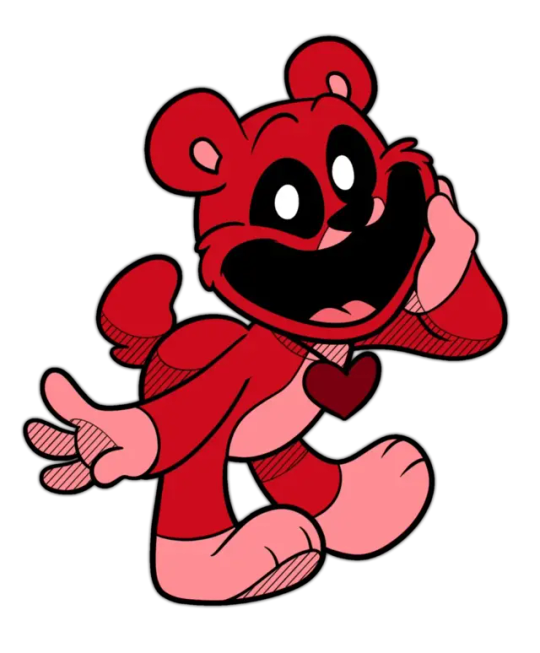

-
Like fr, this is some pretty genius marketing right here. You have enough characters that every kid will have their favorite, but not so many that any would get lost in the shuffle, because the lessons each one of them would teach would be integral to the group as a whole. It really makes me that much sadder we saw basically nothing of the Smiling Critters during the game itself, because Mob Games struck gold with this concept, only to ultimately do nothing with it. :/
But I guess that's what fandom is for, eh?
#poppy playtime#poppy playtime chapter 3#smiling critters#dogday#catnap#picky piggy#kickin chicken#hoppy hopscotch#bobby bearhug#craftycorn#bubba bubbaphant#xi writes#tbh that 'slow and steady wins the race' comment makes me really wish Kickin' Chicken was a turtle instead#just to drive home that parallel even further#ngl i've been thinking about making this post for ages but i finally got off my butt and did it#me holding the Smiling Critters like Marge Simpson holding a potato: I just think they're neat!#it'd be a shame if the game company that came up with them never DID anything with them HUH MOB GAMES?#mob games don't walk away from me#MOB GAMES GET BACK HERE I HAVE THOUGHTS-
1K notes
·
View notes
Text
Dungeon meshi and body proportions
Ok, i'm feeling the rush i got from binging the manga this last week is starting to fade away, i'll be back to being a normal person soon i think. at least, that is before i find a new something for me to dive into uhuh.
Before that happens, i want to praise Ryoko Kui for one last think.
The design of the characters!
For years i've expressed (maybe not so much online) my hate towards the "anime style", this homogenization of traits and beauty standards to an artificial degree, and the mass spread and consumption of it.
yes, trends exist for a reason, this is not the first nor the last art current to be popular and i'm not the first detractor of one in history.
I do think there is something uniquely harmful in this one though, and that is why i'm able to find the energy to be such a pretentious dipshit about it.
That is a discussion for another day though.
All this to say that going through Dungeon Meshi and seiing these characters, plus (and in a way because of it) all the additional sketches of the daydream hour bonus sections, was such a breath of fresh air! (at least for what concerns japanese exported stories)
All i could say and praise in regard to character designs in general is perfectly expressed in this video, which i recommend you to watch if you want to hear my opinions (and the video author's too, uhuh):
youtube
I want to leave you though with at least one specific praise for me: Falin.
i've seen countless time people (online) just not understanding how people's body work, how much differences there can be and how proportions do distribute and affect the body.
in anime I see a lot of short and tall people (mostly women girls) that share the same proportions despite their actual height, and that often leads to think "yeah, she is short" and than she's tall when around someone, or (most often) the contrary. same lenght of limbs, same head to body proportions, and little details like this.
Falin you can tell at a glance she is a tall woman before she's around anyone, even when she is standing near her brother who is taller than her.
Kui did her homework in studying bodies and variations, and, whether consciously or not, she differentiated her in body in subtle but fundamental ways: her head being slightly smaller than her body, the neck being fairly long, and her having somewhat broader shoulders.
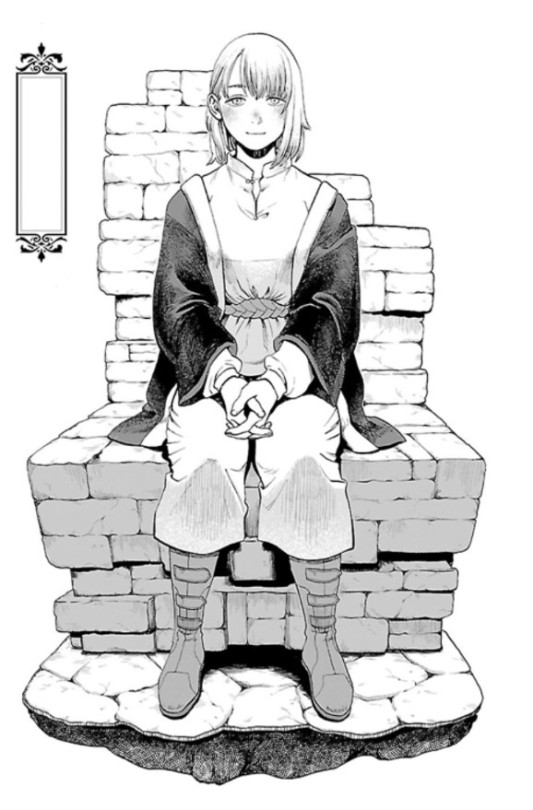


I accept that there might be an element of suggestion at play here, considering also how she is dressed most of the time, but I really do think there is a direct effort at differentiation here.
This is the first time in a long time (in a series like this at least) where i've seen a woman carrying herself around others and the space around here kind of like a person like me, tall, would; at first i didn't think much of it, but then i saw her near other characters and....i don't know, i felt a warm, joyful feeling, seeing that i was right in recognizing that trait and being right.
I was especially happy in seeing her next to marcille. not so much for the height difference, but for how different they were in proportions and mannerism. A lesser manga i fear would have used marcille's body type and way of moving and interacting as the default for most other girls, but here she was uniquely herself!
Now, i could've used more extreme exemples to show how this author rocks in body types representations (while aknowledging there could've been even more diversification still), given there are far larger, taller and stranger women, but to me, nailing the little, most subtle details in such a chirurgical manner shows a greater level of mastery and comprehension. As such, Falin left me with a deeper fascination than most other characters.
Sorry for this wall of text, but i needed to let my happy thoughts go, so that i could be free again uhuh.
Feel free to tell me that i'm wrong, or that i should just accept anime media as is. i'm just really happy Dungeon meshi exists as is and i want Ryoko Kui to keep refining her craft, and drawing beautiful women and dwarves.
Plus, this was very much a stream of consciousness, i didn't go into technical details about what i think conveyed what i described, but if someone is interested, or does not get what i'm saying (while expressing it in a curious and gentle way, i won't respond to spiteful assholes), i'll be happy to make a follow up post in which i try to dissect this! For example, i didn't reread the whole manga to find examples of her, i just went to the wiki uhuh. in a follow up post maybe i'll try to go through chapters and pick more specific examples of her.
Anyway, have a good day!

#tornio#tornioduva#torniod#fantasy#torniotalk#dungeon meshi#delicious#delicious in dungeon#dungeon food#ryoko kui please keep drawing beautiful people#ryoko kui#my head is free now i think#falin i want to hug you#Youtube
770 notes
·
View notes
Note
Harry Blackstone Copperfield Dreden, from the Dresden Files
Mr "The building was on fire and it wasn't my fault", Wizard of Chicago, magical right hand thug of Winter, Dad of a small girl and a spirit of intellect, owner of a temple foo dog and a perfectly normal cat, etc. Has canonically fought vampires of the "black court" which are similar to Dracula. Has met the Dresden Files version of Dracula and survived barely.
Survivability will change according to where you are in the series, so let's say at the current book Battlegrounds. If you like, compare with him at the beginning of the series, Storm Front.
"Survived, barely" I think is Harry Dresden's whole mode of being.
I think the question here is going to be less "will Dracula kill Harry" and more "can Dracula kill Harry." Like of course Dracula wants to kill him. Everyone wants to kill Harry Dresden all the time and they're usually right. He aggros vampires on purpose because he is, if you'll pardon the expression, A Little Shit.
Yeah I was gonna say by Dresden Files rules we probably wanna say Dracula is Black Court? I am going to admit right now that I haven't read the books but I have designed a homebrew Sentinels of the Multiverse villain deck around them so I am broadly conversant with them. I've been told the wildest stuff. Santa Claus is there.
(I have seen the TV series but this is about the books)
The thing is... Harry Dresden is protected six ways from Sunday. He has every anti-vampire measure and he knows how to weaponize the rules of hospitality. He'll find some way that Dracula can't harm him while he's a guest in his home, and use that technicality to be an insufferable brat. He's owed favors by tons of ridiculously powerful entities that would love to see him dead. He's a whole wizard, and, unlike some, actually pretty good at it. He's the Winter Knight (is he still after the whole ghost thing?? I can't keep track?) which has got to do something.
And like, he's got that Jim Kirk sex appeal, rendered all the more inexplicable by the fact that he's fundamentally scrungly. For no reason that I've ever been able to determine (again, it might be more clear if I actually read the books), hot immortal women keep sacrificing themselves for him. It would be entirely in character for one or more of the Girlies to be his ex who hates his guts - but then ends up sacrificing herself for him anyway.
I think mechanically Harry should be able in principle to be just fine, BUT because this is Harry "born to suffer" Dresden he will find ways to make trouble for himself and everyone around him. He's creative like that.
......honestly now I want to put Harry Dresden and Harry DuBois in a room together and see what happens. Someone who knows these guys better than I do get on that.
Anyway I don't think it's a Dresden File unless Harry gets beaten within an inch of his life at least in part due to his own poor life choices.
So in all likelihood Harry Dresden, Wizard of Chicago, can survive Castle Dracula. But, as you say, Barely.
#the dresden files#harry dresden#my impression is that everyone wants to kill harry so bad and it makes them so mad when they can't#and also that he's somewhat of a chew toy but also kinda has it coming#wizards and spellcasters
160 notes
·
View notes
Text
Okay I need to rant about Glass Onion for several paragraphs
WARNING: SPOILERS!
Glass onion is phenomenal, and I personally enjoyed its themes more than the first Knives Out movie.
Now don’t get me wrong, Knives Out is arguably the better film, but its strengths lie in the complexity and brilliant execution of its core mystery. It’s a fantastic self-contained story about a shitty rich family and the people they directly affect. The members of the family range across the political spectrum and all express different ideologies, but the moment a migrant working-class woman has a legitimized shot at their inheritance they band together to prevent her from improving her life. It's interesting commentary on how wealthy people can talk a big game about helping others and being good people, but ultimately fall morally short when such actions threaten what they feel they “rightfully deserve.” But that's arguably the limitation of the film as its focus is entirely on the interpersonal conflict between the Thrombey family and Marta.
Glass onion isn’t limited by that.
The entire thematic core of Glass Onion concerns the damage that the rich and powerful can do to the world if they aren’t supervised, criticized, or limited.
Aside from our lovely detective Benoit Blanc, the murdered Andi Brand, and her twin sister Helen, all of the characters are shitty people that are damaging the world in a uniquely horrible way as a direct consequence of the unchecked power and wealth they wield.
To start we have Governor Claire Dubella. Her success in her political career has relied almost entirely on monetary support and influence from the films big bad and Elon Musk/Jeff Bezos analogue Miles Bron. Her platform has good objectives, and she’s passionate about hard topics like climate change, but her ability to act is entirely limited by the influence Miles has on her. If Miles wants her to do something, she feels like she has no choice but to, which results in her greenlighting an experimental powerplant that Miles wants built to advocate for his new fuel source. It’s untested technology, it’s volatile and dangerous as fuck, and Claire feels like she has no choice but to go along with it because if she doesn’t Miles will withdraw support from her career, or worse, support her opponents. She likens it to selling her soul, and it really is. She willingly undermined the health of her constituents for the sake of saving her career, and the shitty part is that Miles only controls her because she lets him. She could deny the power plant, or leave Miles, at any time, but she doesn’t because she perceives the personal risk as to great. She is a politician that won’t stand up for the people she represents, and no one calls her out on it.
Next, we have Duke Cody, the Alpha male men’s rights streamer who is just like, the absolute worst person in this film. His views and opinions are incredibly toxic, his actions and beliefs directly hurt the people he influences through the hurtful products he promotes, and thanks to Mile's wealth and influence both he and his terrible, terrible, terrible opinions have official backing and some form of legitimacy. He’s almost the direct inverse of Claire, being someone who really shouldn’t have support, but is getting it anyway because he’s Mile’s friend. And because Miles doesn’t care and is giving Duke support and helping him dodge legal trouble, he enables Dukes terrible opinions and lets them influence and hurt people.
Then we have Birdie, my personal favorite of the disruptors. She is a fashion designer, media star, and breathtakingly, beautifully, stupid. She’s not actively malicious like some of the other characters, but she is just so fundamentally incapable of thinking things through. When paired with her wealth and influence, this results in horrifying real-world consequences. She has her iconic fashion line of sweatpants made at the most infamous sweatshop in Bangladesh not because she doesn’t care, but because she thought a sweatshop is just a shop where you make sweatpants. She’s just very stupid, but at the very least has the decency to be aware of it. She even decides to own up to her Bangladesh mistake of her own volition, independent of the plot. The problem is that no one corrected for her, or guided her, or worked to influence her decisions. Miles just cared about what her brands could do for him and was perfectly willing to throw her under the bus to preserve his image.
Last of the four Disruptors is Lionel Toussaint. Not much to say about him actually, he’s fairly straightforward. He works directly under Miles as a scientist and is a parallel for the people that want to have confidence in tech ‘pioneers’ like Elon Musk. After all they’ve been successful, and things have worked out in the past, surely, we can give them leeway with new technology development. But there’s a reason why technology is prototyped and tested, and that’s because things always go wrong, and you need to take time and care to figure out how to ensure new technology is safe.
Which leads us to this asshole.
Miles goddamn Mona Lisa Burning Bron.
The absolute, motherfucking, shithead moron directly responsible for everything bad that happens in this film.
I lied about Duke Cody because this absolute buffoon is the actually the worst person in this film.
He manipulates politicians into endangering their constituents for his own gain, he enables the absolute worst and most toxic people by giving them legitimate platforms, he promotes influencers without caring for what their unchecked actions result in, and he deludes the people that work for him and want to believe in him with self-assured delusion. This man is arrogant, an indiscribable moron (worse than Birdie because at least she acknowledges her failings), dangerously delusional, obsessed with control, and most damning of all, unchecked.
Miles Bron is a direct look at how too much unchecked power, wealth, and influence results in unmitigated disasters. He doesn’t care about helping people, because he doesn’t take the time to make sure untested technology is safe for the public, handwaving legitimate concerns with denial and false assurance. He doesn’t care about his friends, because he murders two of them the instant, they become a threat to his control. He’s not smart, because all of his genius is the result of other people, he’s just skilled at advertising it as his own to get the credit. All he cares about is doing what he wants and being in control, because his opinion and self-worth and legacy is more precious to him than any other thing in the world. The man is a lie so absolute, so convoluted, and so stupidly straightforward that the slightest piece of truth will bring the facade of his existence crumbling down. And it’s hard to acknowledge something like that in the real world because someone that successful being that malicious and dumb sounds incredibly stupid. It’s an easy lie to buy because it’s more believable than how stupid the truth is.
Anyway, ultimately my conclusion is that we see a strikingly accurate portrayal of Jeff Bezos and Elon Musk in this film, and it was very cathartic seeing their hopes, ambitions, and house burn down around them. Because billionaires like them are shithead morons that lie to and manipulate everyone, and their arrogant and harmful self-delusions compound through the people they manage to influence.
Thanks for coming to my Ted Talk.
#knives out#glass onion#benoit blanc#film#mystery film#movie review#elon musk#jeff bezos#Need a hard kick in the nuts#literary analysis#movies#netflix#eat the fucking rich#can't believe a murder mystery radicalized me#rambling
1K notes
·
View notes
Note
youve mentioned offhand ur issues with thirsty sword lesbians, have u talked at length abt this somewhere before and if not do u want to? i want to hear ur thoughts hehe
now before i get into this i want to clarify: i like thirsty sword lesbians, overall! i think it takes some of the best stuff from monster hearts and refines it -- i think it does great and exciting things with pbta playbooks -- i think anyone making a pbta game should check it out because it's full of valuable ideas -- and i've had a lot of fun playing it!
however, i think it's just as flawed as it is brilliant. there's a few different flaws but the biggest one for me is a catastrophic clash between two things the game is trying to be. one on hand, it wants to be a catradora rpg. there's no shame in that, i love games that wear their influences on their sleeves--TSL¹ wants to be a game about kissing your rival after you've both been disarmed, about having a fraught and complicated relationship with your girl best friend who abandoned you to serve the dark lord, about having homoerotic sword duels where your blades lock and you stare into each other's eyes for just one second too long before one of you kicks the other in the chest. i think that's an admirable goal for an RPG and one that TSL hits a lot of the notes of--the fact that the move to "Figure Someone Out" has special questions you can only ask someone when you're duelling them is incredible design. the Strings system, adapted from Monsterhearts, the ability to fluster your enemies when you use the Entice move, the constant focus on what characters desire and how their actions conflict with those desires--so much of the game is working towards that!
unfortunately, the game also wants to be about queer resistance to homophobia and capitalist/imperialist hegemony. this is clear in its sample settings, with their eyerollingly on-the-nose conflicts like defending 'queertopia' and fighting the evil sorceress 'repressia'. but much more importantly, it's clear in the game. several of the playbooks are defined by their relationship to sexual hegemony--the beast is about someone who is othered and monsterised for expressing their existence and the seeker is about someone sheltered and prejudiced moving past that and discovering themselvs and others. like, it's not subtle--
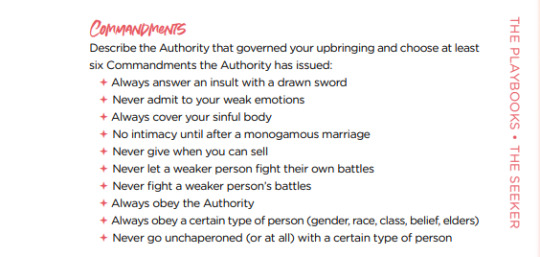
and to be clear, there's nothing wrong with that, either. just as i like a lot of TSL's swashbuckling girl-romancing flirting-at-swordpoint mechanics, i really appreciated how (although the game's outlook on what these forces are is predicably liberal and its tonal approach to these things is one that i personally find teeth-grindingly insufferable) these things are actually integrated into its mechanics. playbooks like the beast and the seeker (and the rest!) imply something about the world the game is set in and its sexual politics. this game is meaningfully queer in the way something like dream askew is, in that its mechanics ask you to actually explore your character's queerness specifically. this is good, and it's something that elevates it above about 90% of ttrpg stuff that sells itself as queer.
so if both these things are good, what's the problem? well, it's that they're two great (or at least--interesting) tastes that go fucking horribly together. the fundamental problem that i have with TSL and one that i think takes a lot of work to get around in your own campaigns is that it simultaneously wants you to be fighting (on the individual level) a lot of antiheroic ultimately sympathetic hot girls you can flirt with and kiss--a lot of 'i can fix her's or 'she can make me worse's--and on the broader narrative wants you to be fighting institutional queerphobia (and often, although this is nowhere near as actually supported by mechanics, a more generalized 'imperialism' or 'capitalism' or 'bigotry'). so you end up fighting 'those stupid sexy homophobes'--people who are according to the text (not just 'lore', but the rules text, the mechanics you're playing with!) simultaneously the violent enforcers of cisheteropatriarchy and a bunch of fuckable lesbians with sympathetic backstories.
& i just think those things are fundamentally at odds. the result is a game that if you try and play it at face value works at cross purposes with itself, attempting to do two perfectly valid things without considering what happens when the streams cross.
it also has a few other flaws--like many other PBTA games, its balance falls apart if you play any long campaign (my group and i had to figure out special alternative level-up rewards!) but it comes with no inbuilt way to neatly conclude a campaign or character. its tone is something that, as i often mention, i absolutely cannot fucking stand--it has a certain sense of humour that feels profoundly dated to me and was never my cup of tea when it was in vogue. this is something i try not to hold against the game bc it is very much a personal taste-level 'cringe' reaction but the game lays it on pretty fucking thick.
more to its detriment, it is profoundly, gratingly liberal in the exact way people who deploy that tone usually are. its understanding of anything outside queerphobia specifically is just a purely aesthetic & thoughtless 'imperialism is bad!'. it manages a more nuanced understanding of homophobia, but it only manages it on the individual level--for a game about queerness and about fighting systems of cisheteronormativity, it has no systemic or material understanding of these systems and no interest in establishing one.
and finally--and this is just one paragraph but it's so fucking awful i feel the need to complain about it here because i think about it often as an example of something i never want to write:

this sucks! real bad! so deeply fucking silly to reassure people in your game that you called Thirsty Sword Lesbians that it's okay if you want to be cishet. like, it would be one thing to make a game where you can neatly extract the lesbianism and have the same game, a surface-level aesthetically queer game with no actual interest in queerness except as a marketing term. it would fucking suck but this paragraph would at least describe such a game. but TSL isn't that!!! . 'thirsty sword cishets' would be a very different and much worse game! awful and self-defeating paragraph. deeply silly concern to address and give airtime to. i didn't buy a game called 'thirsty sword lesbians' to be told 'its okay to be heterosexual i pwommy'
so yea just to reiterate: i like the game overall, i think there's a lot of good valuable stuff in there designwise despite all this. but i'm very ambivalent about it--ironically, i feel a love-hate relationship with this game about love-hate relationships. i admire it and yet i despise it! i long to put it at the tip of my sword and slowly tilt its cover up so that the pages look up at me coquettishly but with burning anger in their page numbers. if this book was a person id hatefuck it, is the joke, thats the joke im making, here, in this post. thanks
¹ i call it TSL whenever i can because the name 'Thirsty Sword Lesbians' makes me cringe out of my fucking skin. genuinely horrible name. i'm sure it's funny the first time you hear it, i got a mild chuckle the first time i heard it to, but it's such an obnoxious thing ot have to say repeatedly when seriously discussing it. should have stayed a placeholder name amiguitas
219 notes
·
View notes
Note
Wait what guy who hadn't read Atlas Shrugged?
I was pretty sure I'd told this story here, but a cursory search suggests that I have not. Okay let's gooooo
Many moons ago, I worked in an emergency services call centre. I worked nights- I could get regular shifts, it paid well, and I am a huge freak, just like everyone else who works nights in a call centre. It is a lifestyle that attracts freaks. Some of my coworkers weren't full-time creatures of the night, but students or whoever who picked up occasional nights for the extra money, and one of them was Libertarian Shithead, who we'll call LS for short.
LS was a twentysomething white dude who wore a lot of name brand surfwear and designer sunglasses. I assume his parents were rich. LS loved nothing better than recreational arguing. Unfortunately, he wasn't very good at it; he had some of the most dogshit opinions I've ever encountered in the wild, and was terrible at defending them. He'd say some crap about how Gattaca-type eugenics is Fine, Actually, because if you let people make designer babies, the ~*Free Market will decide what traits are desirable! Racism and colourism and ableism and sexism and intersexism won't affect those choices at all! And I'd get mad, because I have principles to speak of, and we'd get into it, and WITHOUT FAIL, we'd get maybe halfway into an actual discussion about whatever horseshit garbage he was on tonight, and the second he thought he was losing, he'd say "oh, well. I'm an ~*Objectivist, so you can't really understand my perspective unless you've read Ayn Rand." Then he'd sigh, and change the subject.
At the time I had not read any Ayn Rand. Being fundamentally powered by spite, I withstood maybe three weeks of this shit before I pirated an epub of Atlas Shrugged, put it on my e-reader, and proceeded to slam through it at supersonic speed so I could finally get to finish an argument with this terrible boy.
Anon, I fucking hated Atlas Shrugged. The book is bad. It's way too long, every single character is an unbelievable douche, the prose sucks. Ayn Rand wants to fuck a train so so so badly, but the prose is so turgid I couldn't even get invested in how much she wants to fuck a train. And the core of the matter, the politics I was there to understand, are, y'know. Objectivist. Eye-bleedingly selfish and capitalistic, expressed in amazingly childish and blinkered terms. Even the bits where it seems like the shithead capitalist dudes want to fuck each other are too mired in the scunge of Rand's terrible views to be enjoyable.
But I read the fucking thing! I powered through it with only quite minimal complaining! I finished the book on the train to work, and when I saw that LS was on that night, I plonked myself in a seat by him, and metaphorically cracked my knuckles, ready to fuckin' party. In a perfect world, I would have been cool enough to have waited for the perfect mid-argument moment to drop, but I didn't. I think I lasted exactly until we were both off a call at the same time, and then leaned in as close as the desk dividers would let me, and said "So I finished Atlas Shrugged. I have some thoughts."
I cannot overstate how quickly it became obvious that LS had not read the book. For a hot second I thought maybe it had just been a while and the fine details had escaped him, but no; he didn't know who half the characters were, or key points of the plot, or even know any of the stuff in the John Galt speech, i.e. the big juggernaut of Here's How Objectivism Works near the end of the book about Objectivism that this fucking guy hypothetically based his Objectivist views on. It took me maybe five minutes, in between calls, to realise this, and another five for him to admit he hadn't actually read any Ayn Rand. He'd read her Wikipedia page.
ANYWAY I didn't speak to him for like a month after that, and I don't think either of us lost out there!
#at the time I was very angry#but in hindsight I think it was very funny#storytime#ask me ask me ask me#anonymice
152 notes
·
View notes
Note
So…
how are classpects supposed to work, I thought they where tided to narrative role of sorts.
you are asking the wrong person, i am a full blown classpect iconoclast. my position is that classpects are literally just power sets in the same way a job in final fantasy 14 is, or a dnd class is, they're a way of expressing "here's what this character can do diegetically" and homestuck fans have an insistence on scaling that up to a level of metatextual actions, since in act 6, homestuck deals primarily in metatextual violence, but there's actually not any meaningful basis in this
from a homestuck analyst's perspective, text we do get on the matter is suspect, since it's from calliope. calliope's relationship to homestuck (or at least, the idea of homestuck as expressed by rose into her journals, which calliope was reading from) is framed very similarly to the relationship vriska has with mindfang's journals, and is positioned in the story not terribly long after death of the author as an idea becomes a fixation for homestuck. meenah compares rose and mindfang directly in openbound and calliope is notably wrong about basically every other thing she theorizes on, such as humans having wings and the origin of the penis ouija in rose's journals, just as vriska fails to recapture the essence of mindfang when she has to act on that herself
and from a fanfic writer's perspective, i've seen a lot of people play up their classpects. a really common refrain in fankid/fantroll spaces is trying to use a classpect as a hook or a catchall for a character, asking questions like "what kind of personality would a seer of breath have" (for some reason "seer of breath" has come up like, 4 times on its own. people want that good seer of breath) as if this is anything meaningful to go off of at all - classpects as character templates, as a skeleton key for the narrative code of homestuck. actually, the only time a character's classpect reveal has been genuinely cool to me is in my friend lupa's comic wake up, at the end of act 1 where the premise is revealed.
i genuinely just think classpects are a power set and nothing more - not to say that they're meaningless, of course, more than anything i'm a game designer by nature, and one of the fundamental rules of such is that your tools shape you as much as you shape your tools, but i think so, so much of it is just total bullshit you can rip out and/or ignore and just burn the fuck down in general
117 notes
·
View notes
Text
who holds the mask? designing the Disguise
For the record, all of the playbooks in Beneath Pirate Flags are trans. Gay ass trans ass pirates. I mean, they don’t have to be — the magic of character creation means that you could make anyone, even (!!) a cis person, if your imagination can handle that. But they’re all more or less about being trans, or about types of trans people I know, anyway. Maybe none of them is as trans as the Disguise, though.

I don’t mean that, of course. The Disguise isn’t “more trans” than any of the others in any way that matters. What I mean is that the Disguise is maybe the most “obviously” trans, the most “typically” trans. The Disguise deals with a narrative that people see and go oh, oh, I know this—that one’s about being trans.
The Disguise is a pirate “on the run from at least two things,” inspired by tales of putting on a (you guessed it) disguise and escaping to adventure. There’s a lot of Jim from Our Flag Means Death in there, of course, as well as a good amount of Eowyn and not a small percentage of Alanna of Trebond. The Disguise is playing in a lot of tropes that make people conscious of the play of genders—which, for complicated reasons, reads as “more” trans than, say, The Hunk, The Dandy, or The Legend (even though all three of those are, to me, far more fundamentally drawn from my own trans experience).
One of the big things I wanted to do with the Disguise though, was offer more nuanced understanding of the work masks and disguises can do than we usually get in these types of stories. In the most traditional—the most recognizable—version of this narrative the Disguise is a cis woman who, frustrated not so much with her gender as with institutional sexism, takes on a mask in order to “play” as a man and trespass in the wider world (the historical erasure of transmasculine people into the cis feminist figure of “the woman in pants” looms large here). In this narrative, there comes a point where—as in Mulan, Eowyn, Alanna—she is unmasked but accepted as, to borrow a term from Tamora Pierce “a woman who rides.”
Here’s the thing: That’s a valid arrangement of what’s in the Disguise. There’s no reason the Disguise couldn’t be used to tell this kind of story—but I think there’s a more interesting version of this character out there, probably most clearly expressed (in popular media, anyway) by Jim Jimenez in Our Flag Means Death who, critically, does not return to their assigned gender after removing the “mask.” After all, there’s no reason to think that the mask must be something taken on (as opposed to, say, assigned). Rather, I like to think about the Disguise as playing across a border—dealing in multiple frames and knowledges, and trying to make space for themself between them. One day—if all goes well—they won't need the mask anymore. The playbook could equally viably tell the story of:
A cis woman under patriarchy, “playing a man” so she can run away and be a sailor (like Eowyn does).
A trans person, “playing” their assigned gender as they work to find out who they are really (like... most if not all trans people do, at one point or another).
A trans person, “playing” their true gender (or at least a new gender) as they build a new understanding of themself in a new context (this is the reading I think is closest to what happens with Jim, fwiw).
A person whose disguise has nothing to do with their gender at all—maybe they’re a prince in hiding, or they're pretending to be a prince in hiding, or there's something else.
There’s also no reason that the playbook couldn’t combine these stories—or even reach for new ones that haven’t occurred to me. The possibilities are endless. The core of the Disguise is not about secrets and falsehoods (although secrets and falsehoods certainly play their part), but rather performance and autonomy over your own presentation. The mask is a tool to control that presentation.
This brings us to the saddest part of the playbook—the ending.

Every playbook in Beneath Pirate Flags has three prewritten endings (although you’re naturally welcome to come up with your own). Each set of three has two happy endings and one sad one— sometimes bittersweet, sometimes tragic, and sometimes just bad. For the Disguise, that sorrow is all about the loss of control. The worst thing that could possibly happen—the most upsetting ending, which I want players to be aware of even if they aren’t interested in it—is not just the removal of the mask, but the removal of the mask without the Disguise’s permission or control. The world longs to control our presentations and, by doing so, control our lives. There is magic in a mask, and in the autonomy it provides—but there are people who want to rip both of those away. They want to hurt you, to control you, and to make you hurt yourself. That’s what we’re fighting against.
Anyway, there you have it. Go hug a trans person—and check out Beneath Pirate Flags.
#beneath pirate flags#our flag means death#ofmd#jim jimenez#eowyn#alanna of trebond#trans#indie rpg#indie ttrpg#ttrpg design#gay pirates
93 notes
·
View notes
Text
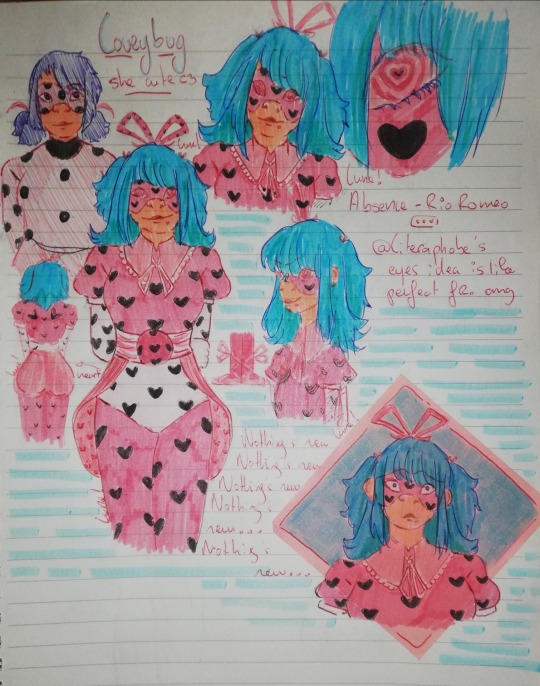
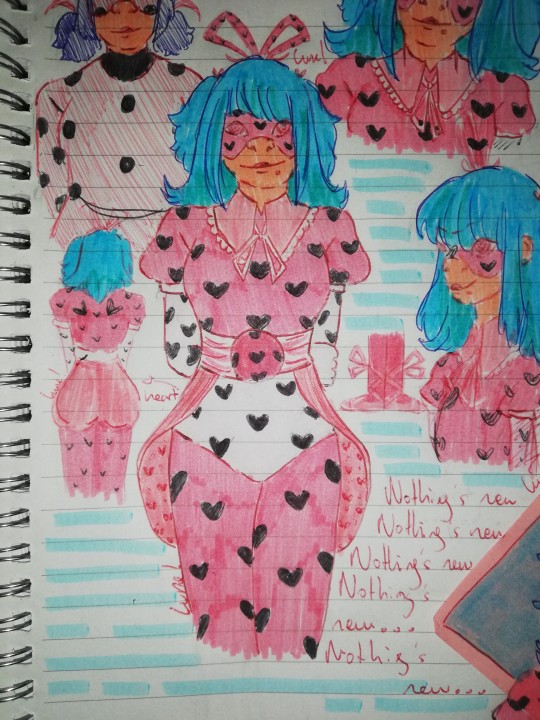
Loveybug au design. I love her your honor. Listen to Absence by Rio Romeo.
Sorry about her skin looking orange I have shit pencils.
The "white" parts of her suit are actually very light pink.
I just really wanted her to look like a princess.
Her hair is mostly down so I count it as following the original post lol.
I didn't really enact it in the drawings but I think her bow like. flops down when she's sad.
They're not real ballet shoes because that would be terrible, they're soled ballet shoes looking flats.
In her efforts to look graceful and romantic, she becomes clumsier and more anxious. As in, worse than as Marinette.
Her hair is pastel blue, it's not me having shit pencils this time. She's generally very pastel, except for her eyes which are a whole other kind of hell; talking about her eyes, thanks @literaphobe for the absolutely delightful idea of her having that hypnosis spiral looking thing in her eyes.
I'm bad at showing it, but the heart shaped fabric "tail" at her back is very light and somewhat transparent + shiny.
She has heart shaped "wings" in her back, because she's an angel.
I think lesbians probably like her in-universe. She also probably becomes a fundamental part of every lovecore pinterest board.
If she breaks out of her character, her eyes go back to blue. That generally happens when she's too stressed to maintain her facade, or when she's just straight up having a break down.
I think maybe, her mask is stiffer to stop her from making facial expressions that are too harsh. Because she doesn't want to get angry at Cat Walker, does she?
I really wanna write a very angsty fic about this whole thing but I haven't watched the show in too long. I'll probably read wikipedia pages or something.
#check the loveybug au tag if you want to know what the fuck this is;also i obviously am taking this thing in the angstiest way possible#loveybug au#mlb#miraculous ladybug#marinette dupain cheng#miraculoustalesofladybugandcatnoir#miraculous fanart#miraculous lb#miraculous au#ml ladybug
90 notes
·
View notes
Text
An Analysis on the Literature Girl Insane MV!
Hey! You might not know me that much, as I’m not active in the DRDTheory community, as I’ve dubbed it, but my name is Blanket! Technically, this is a work of collaboration between the majority of DRDT Twitter, but it’s mainly just an analysis of stuff I couldn’t do by myself.
Okay, and now, onto the video!

So we start off with the spoiler warning. Pretty standard stuff, of course.
Many of my theories beginning here will be based on the colors and what I, personally, associate them with. Of course, the actual MV’s contents will be looked at further down the line.
As a bonus, take note of what pops up right after that. It’s a question: Do you want to forgive... someone? We’ll answer this question later on in the theories section.
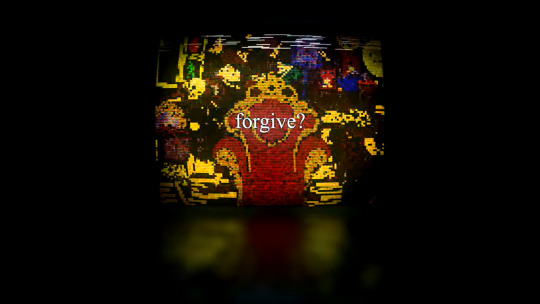
These are mainly just lyrics, but the “final verdict” part catches my eye, as I believe it isn’t in the lyrics further down the line. Perhaps it’s about the current trial? As many people believe, David did not kill Arei. His reasons for lying about doing so are unknown, but we can assume that the singer is calling the listeners idiots, because of their incorrect final verdict. Whatever David wants to do, it’s certainly not leading them to the right one.

Next, these lyrics. While I believe it’s fairly obvious that the pink is meant to represent the typical Danganronpa-esque color of their blood, the color that the word “game” is in is probably relates to David. After all, his hair clips and star eyes, both prominent features of his “facade”, are in the same color.

Here is where the most prominent part of the MV is, to me. The text that flashes across the screen during transition points. The first one, in white text, is an excerpt from Osamu Dazai’s “The Flowers of Buffoonery.” The book, while I’ll spare you the greater details, greatly describes themes of suicide. The story’s main protagonist, Yozo Oba, can be described as so: “-But the narrator, a self-conscious writer, makes frequent first-person asides, breaking the fourth wall as he comments on the quality or believability of the novel he is writing.”
Something especially telling is this line, from an analysis of Yozo’s character. “Yozo is a person characterized by shame. Although I pretend to be someone who is confident and unabashedly themselves, that is not really true. I have always been ashamed of who I really am. I created a whole persona to interact with others because I believed my true self would never be enough.”
David’s character is someone very similar to that. Someone who has created a false persona to interact with others. Yozo is someone who feels resentful of other people, simply because he is forced to make them happy.
“Yozo Oba is the tortured author and unreliable narrator of the three notebooks that comprise the bulk of No Longer Human. [That is the sequel to The Flowers of Buffoonery.] His appearance is depicted in three photographs examined by an unnamed narrator in the Prologue. These three photographs correspond to his appearance in each of the three notebooks. As a child, Yozo is precocious by design—an impish child who uses his antics to hide his fear, shame, and inability to relate to humanity. These fundamental flaws carry over into young adulthood; in the second notebook, he is a handsome young man whose smiling photograph lacks humanity, betraying the depth of terror and isolation that his comical persona seeks to hide. In the third photograph and notebook, he is only 27, but his gray hair and forgettable appearance prevent him from being labeled an ordinary human being.”
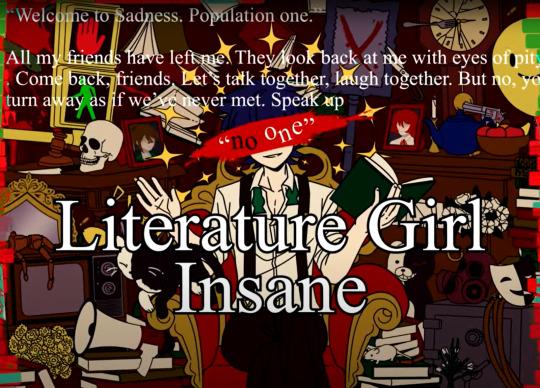
The quotes in yellow are from Agatha Christie’s “Murder on the Orient Express.” The full quote reads as follows. "If you confront anyone who has lied with the truth, they usually admit it – often out of sheer surprise. It is only necessary to guess right to produce your effect."
I think the relevancy of this line in terms of David can be explained with his actions so far. Fun fact: Similarly to Danganronpa, “Murder on the Orient Express” is a murder mystery.

This is just a rickroll. DRDTDev thinks that they are FUNNY!? (They are.)

The “an archaic personal pronoun rarely used in real life, but popularized in fiction by the book” is most likely referring to thou/thy/etc. I’m not sure what this correlates to, but it’s probably important. I couldn’t find the green text, but from what I can tell, the green text probably relates to David’s nihilistic point of view towards humanity.
Update: Bleuflower on Tumblr has located the source to be I Am A Cat by Natsume Soseki, so go check her out for that! If I had to say anything about that, it’d probably be relating to MonoTV, however, there’s also a continuation of David’s nihilism towards humanity that was also found in the Osamu Dazai references. The book itself is described as a “mordantly comic evocation of Sōseki's deep pessimism about his own humanity and indeed about humankind in general.”

The white text here is an excerpt from Osamu Dazai’s “No Longer Human,” which follows the same protagonist as “The Flowers of Buffoonery.” I’m sure you can all gather what that means in relation to David, but the main point is that he seems detached from his view of “normalcy.”
@shidoutism on Twitter had this to say, as they’ve read the book itself:
“OKOK so basically this first excerpt is from 'no longer human' by osamu dazai (its his last finished work because dazai sadly took his own life after publication of the book) now from the limited knowledge i have of david the meaning and message of the book might help in whatever analysis ur doing?? no longer human is about a man who never felt like he understood humans. like the title suggests, he never felt like a person. its revealed the protag was pretty sheltered and rich in childhood but experienced trauma from the familys housekeepers, but he never reported it. thats basically the start of it all as the protag grows up, he finds fear in communicating with humans. so he ends up either isolating himself and/or destroying all of his relationships with people. he's scared of people seeing the real him, so ever since he was a child he started putting up a happy, cheerful front. but it just creeped some ppl out bc it didn't feel genuine, it was more like a clown wanting to so badly entertain others. the protag starts resorting to bad coping mechanisms such as dr/gs and alc/hol and has many relationships with women to drown his sorrows and feel closer to being 'a human'. aaand the end of the book is kinda unsettling as the protag is sent to a rehab center and then when released, isolated himself somewhere far away without people, stating "everything passes. thats the one thing i learned in this living hell [somewhere along those lines]" and the book ends numbly like it feels like nothing”
I don’t know about you, but this sounds rather similar to our “protagonist.”

This quote is from “The Setting Sun”, by, you guessed it, Osamu Dazai. It tells a similar story, albeit with a different protagonist, but I feel like this ties in more with his facade, and how his inspirational speaking comes off to other people. Considering he is in his facade at this time of the MV, it’s safe to say that that’s what this is referring to.

And now, this all falls into place. These are the names of the Osamu Dazai books referenced in the text beforehand. The (I’m), next to No Longer Human, however, could signify how David views himself. Someone so sunken into depravity that they don’t register themselves as human anymore.

The faded text here is the first sentence of Yasunari Kawabata’s “Snow Country”. I don’t know what this refers to in terms of David, but this also seems important.

David still views himself as manipulative. Even if he does love people, even if he does have a semblance of care for those in his life, he views himself as an evil, irredeemable sack of shit, incapable of any emotion other than selfishness and cruelty.

This part is especially intriguing to me. David still wants to live, as anyone else does, but he can’t bring himself to find a reason to leave. His career is dead. He’s worthless, and nobody needs him around. Where would he go? There’s no room for him anywhere, even if he escaped, he’d just be shunned for good now that his entire life has been thrown away.
The excerpt from “And Then There Were None” by Agatha Christie, describes someone losing motivation to leave the island. The island is a metaphor for the building, that the students are trapped inside, and David has lost the will to leave in the first place. He doesn’t want to leave, because there’s nowhere else for him to even go. He doesn’t have a home. He doesn’t have a fanbase. There’s nothing left.
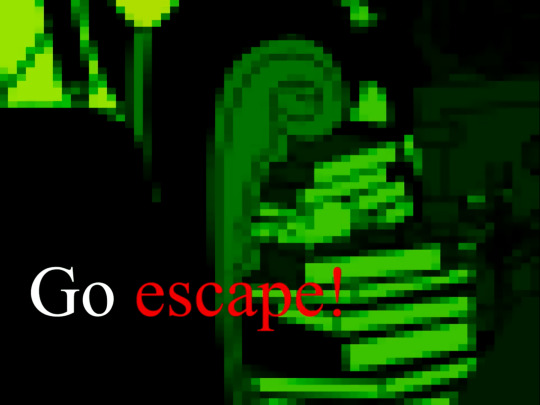


The text here reads: “If you’re Hythlodaeus, then I must be Morus.” This refers to the work “Utopia”, written by Thomas More. The book follows Raphael Hythlodaeus, a man who claims to be from Utopia, a perfect place for everyone. His surname quite literally means “Bringer of Nonsense,” or something along those lines. While this may be a stretch, I believe that “Hythlodaeus” is referring to Pre-Reveal David, and “Morus” could possibly be either Post-Reveal David or someone affected by his speeches, for example Xander.

Also, I find it interesting how the girl in this frame, most likely David’s “sister,” Diana, and David himself are both tilting their heads at similar angles. It’s possible that their relation is hinted at through this, but I’m not sure.

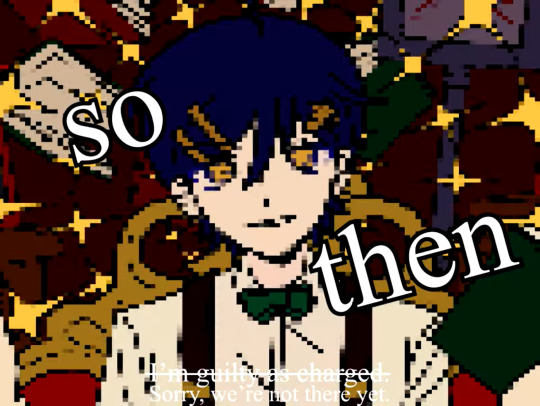
The excerpt right here is from Kajii Motojiro’s entry in the Kyoto Journal, entitled “Lemon”. While some of the text has been altered, the main story is about a man who finds himself suffering, and walks through his neighbourhood only to find a greengrocer selling lemons. He goes home, and finds himself happier than before. I’m not sure what this means when it comes to David, however if you’d like, you can analyze for yourself and let me know.
https://www.kyotojournal.org/fiction-poetry/lemon/

This part doesn’t have any external references, but I believe that the lyrics here reinforce David’s worldview, that no matter what you do and how hard you try, “nobody ever changes.”
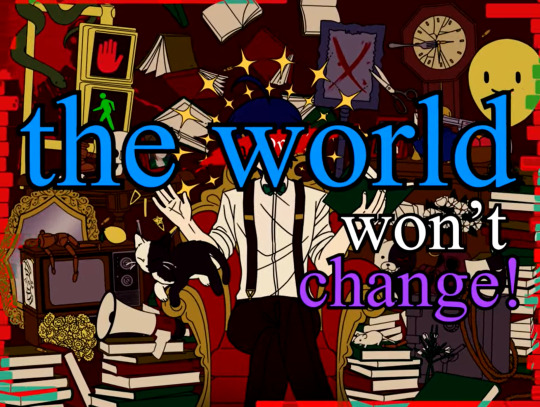
The star imagery here is a direct reference to David. Stars are representative of his happy facade, and when he loses the stars, he quits the bullshit.
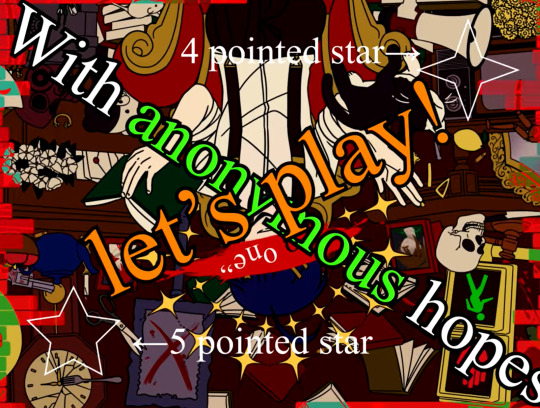
…And this frame. Alright, let’s start from the top. The electrocution definition is a callback to Xander, who’s referenced quite a few times in the video. The yellow text, which is from Antoine de Saint-Exupéry’s “The Little Prince”, is possibly a reference to David’s view on other people or himself- That nobody is special unless you were born special. However, the end of the text describes that if the boy were to tame the fox, the speaker, that they would need each other. I’m not sure if this is a description of manipulation, or a codependent relationship, but the David parallels are there. That, and the title of a “little prince” probably refers to David and how he’s idolized by many. The green text is, again, from “The Flowers of Buffoonery.” The full text is as follows.
“A man crushed by reality puts on a show of endurance. If that's beyond your comprehension, dear reader, then you and I will never understand each other. Life's a farce, so we might as well make it a good one. But real life is a realm that I may never reach. The best that I can hope for is to loiter in the memory of these four days, so steeped with empathy. Four days that count more than
five or ten years of my life. Four days that count more than a lifetime.”
In reference to David, this is more representative of his true feelings. Not the asshole persona or the facade, but the genuine feelings he has. He already feels far too gone by his own standards, and constantly puts on a “show” for other people in the form of his speeches.
The red text is possibly a person dealing with depression speaking on one of their symptoms. There’s no way I could find a source for such a short quote. A common symptom of depression is losing interest in things you previously found enjoyable.
The white text on the side describes someone who finds pleasure in solitude as opposed to being bossed around by other people. It’s a reference to David’s backstory, as someone who was pressured into putting on a performance for others, finding comfort in being alone rather than having to play pretend whenever around other people.
The white text at the bottom is a continuation of the white text at the top.
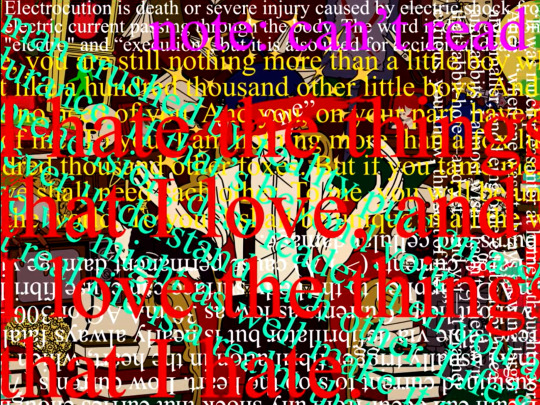
The only theory I can think of for this is that it’s a foreshadowing to either gaps in their memory or the amount of survivors left in the killing game being four. Not sure.
Update: I don’t know how I missed this, but the “11” next to the suspicious gaps refers to this. It’s possible that the suspicious gaps are gaps in their memory now, being as he doesn’t remember having an older sister, but her existence is most likely confirmed, as we saw her.
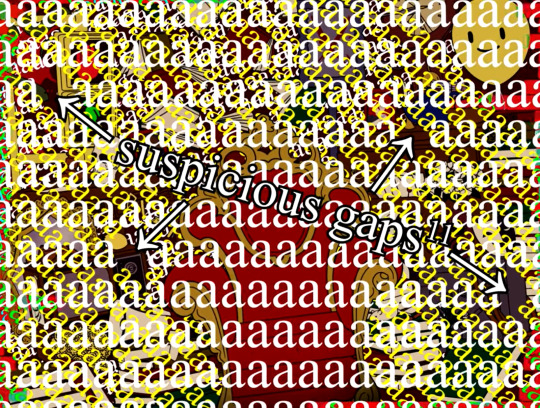

This part here is referring to “Catch 22,” when the main character realizes that without a soul, humans are just… matter, if you will. Empty husks.
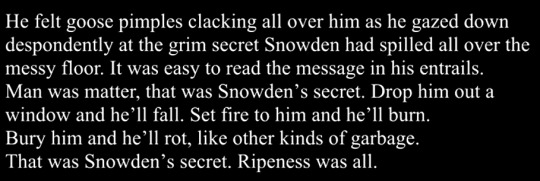
For this part, I had to call upon my not-so-trustworthy old friend, Google Translate! The translation of this from Latin is “I think, therefore I am (not.)” That’s what makes the most sense to me. We’ll refer back to this part later, for I have a different intention for it in my mind than David himself.

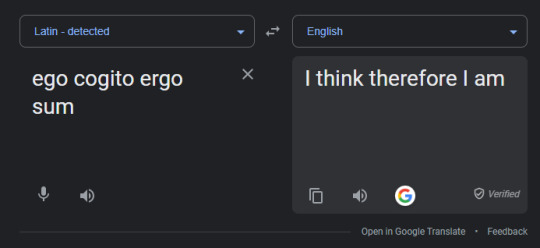
The dark blue text is another excerpt from “The Little Prince.” The prince in question is talking to a castaway, and the main takeaway of his words is that only your heart can tell you what you really need. If you were to simply look with your eyes, then what you truly need would be drowned out by the blinding light of superficial desires. I’m pretty sure that’s what that means. David is looking through his eyes, seeing a cruel world where nobody changes unless they were born to.
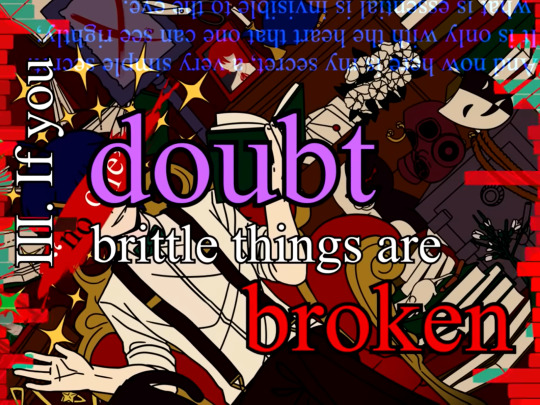
Now, let’s get into the next big part of the MV: The crossword puzzle. You might be wondering how this relates to David, but its moreso his own commentary on his classmates. Let’s go back to the latin. Pay attention to this reference of the solved crossword by raspbeyes on Tumblr. It will be very important for you to follow along.

Notice how there’s roman numerals in some of David’s lyrics? For example, this that we established earlier meant “I think therefore I am (not.)”
This is referring to Rose. Her photographic memory can be linked to the description of “thinking.” The context of this may become clearer in future parts of the story.

III. That’s Charles. “If you doubt brittle things are broken.” Is, in my mind, referring to his memories. He has a recurring element of not remembering things, but he doesn’t seem to be aware of this until Chapter 2. For example, his secret- “Your older brother died, but you don’t remember him at all.”

IV. Arei. Her breakdown sequence should be all you need to associate this with her.

V. This is Ace. He’s going insane, obviously, because of the paranoia and failed murder attempt against him. That, and he’s become more disheveled as the game progressed.

XIV. Veronika, correct? Substance to the arts relates to her talent as a Horror Fanatic. Naturally, she’d be related to things like that.

XV. Whit’s refusal to accept his mother’s death, staying ignorant to the tragedies around him, is one of the “happiest” members of the cast.


XI. Mai Akasaki is not mentioned in the current story, and all of her quotes hidden amongst the cast members describe her in past tense. She was someone everyone viewed as reliable, trustworthy, and perhaps, if you exaggerated it, as God.
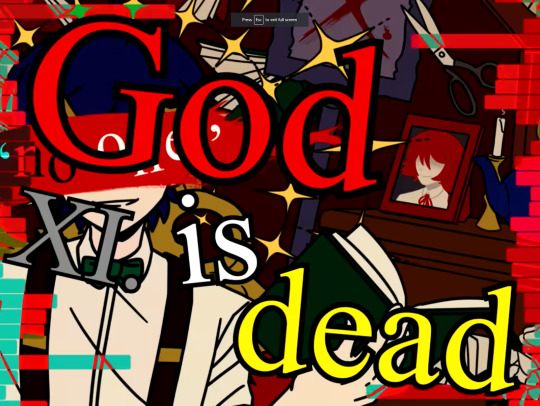
These two walls of text are both from the same source: Hamlet’s Solliloquy of “To Be, or Not to Be?”

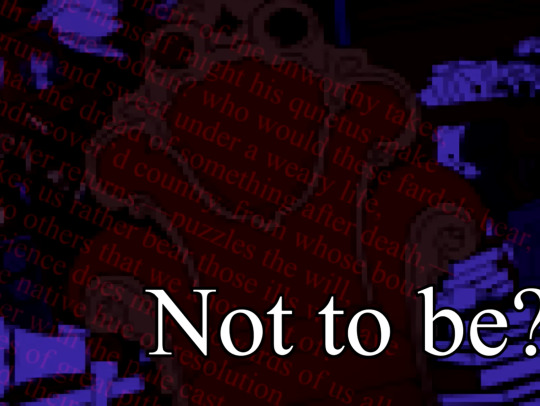
This is what the thing actually means, in case you aren’t aware, which even I wasn’t until just now. It represents David’s suicidal ideology, from what we can assume with the way he’s trying to get everyone to vote wrong in the trial for Arei, quite well. Whether he wants to live, or die, is most likely a constant struggle for David to answer.

Which is why he leaves it up to… whoever can answer.


This is an absolute reference to the trial. The class trial rules are overlaid over the death portrait texture, which is “conveniently” covering David’s face. The seventeen here is also telling, considering what the description has to say about it!


This is what I believe is David’s end goal. To get everyone executed as a result of his own hopelessness. By pretending to be the killer and antagonizing the class, he believes he can easily sway the votes by “manipulating the public” as he always believes he’s done. By getting everyone to vote for him, he can end the killing game and his own “pathetic life” in one fell swoop.
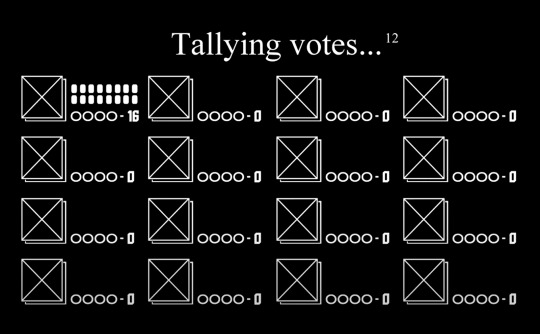
After all, it’s not like he believes they have a chance of winning and escaping in the first place.
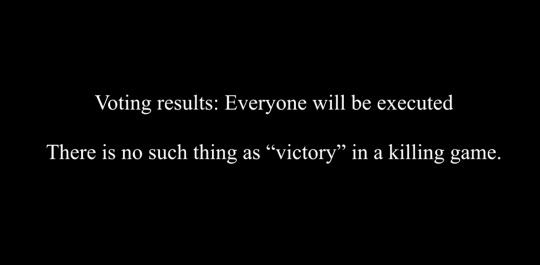
And here, is where we left off in Episode 11. David completely drops his facade in order to effectively kill himself, along with everyone else. After realizing the hopelessness of his situation, he makes a drastic turn to accept it readily. Someone who self-sabotages continues to do so because they develop a warped perspective of having control.

And again referring to the description, the 12 near the “Tallying Votes” caption refers to this. It’s David’s way of justifying his selfishness, with a diluted form of justice serving as an “ultimately fair verdict to the trial.”

However, David has always wanted to be loved. It’s why he even bothers with his facade, because he’s been putting it up for so long that disregarding his persona would effectively ruin everything he’s worked so hard to maintain in the first place. The repeated imagery of applause could also be a callback to his status as a celebrity, especially with how he reacted to Xander and Arei’s reliance on him.
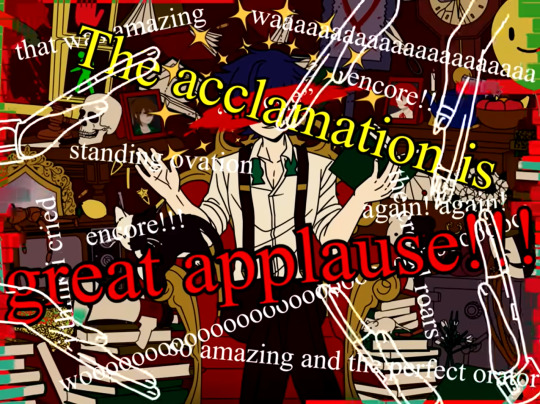
While this does have a small fade of text pointing out that the “degraded copy” is the cover, which is not true because the MV is amazing, but. I believe this–

Oh. That’s literally it. Well, that makes one mystery solved!

Hey, look, we’re already halfway through! nice!
Eden’s optimistic personality can be referenced here. She wants to live with everyone, together, and make sure that nobody gets hurt.

This is another reference to David’s rambling on about how attempting to change is utterly futile, and that nobody changes.

The yellow text is the definition of a television show, I believe. The blue text is an excerpt from “And Then There Were None,” by Agatha Christie. The full quote is this: “Breakfast was a curious meal. Everyone was very polite…. Six people, all outwardly self-possessed and normal. And within? Thoughts that ran round in a circle like squirrels in a cage…. ‘What next? What next? Who? Which?’...”
…Do you get it? It’s a parallel to the killing game. Or, rather, how David views it. Everyone is terrified and scared for their lives, but they still greet eachother with mock kindness.
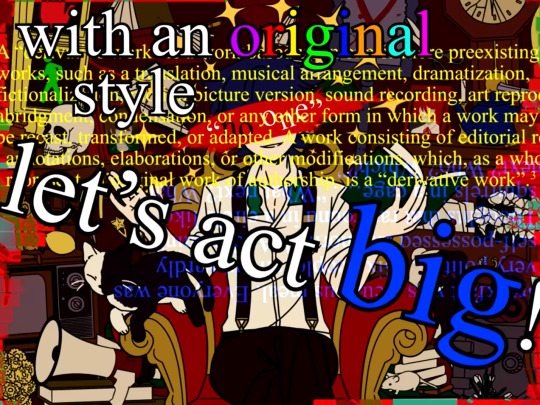
The blue text on the side is an excerpt from Shakespeare’s “Macbeth.”, and it goes like this: “I am in blood / Stepped in so far, that, should I wade no more, / Returning were as tedious as go o'er.”
A critical analysis of the original work reads as follows:
Shakespeare is saying here that Macbeth has involved himself in so many murders that it is as easy for him to carry on than to turn back. Macbeth compares his course of action with wading across a river of blood, creating a vivid image of his bloody reign. The word 'tedious' reveals the hardening of Macbeth's heart.

And now, the moment I’m sure most of you have been waiting for. Xander. Something I took notice of was that the cracks line up directly with his left eye, while his right eye is the one that’s actually missing in the game. Nonetheless, Xander clearly did mean something to David. Whether it be through his idolization of David, or if he inspired David in some way, his death had an impact on him. Manipulative persona or not.
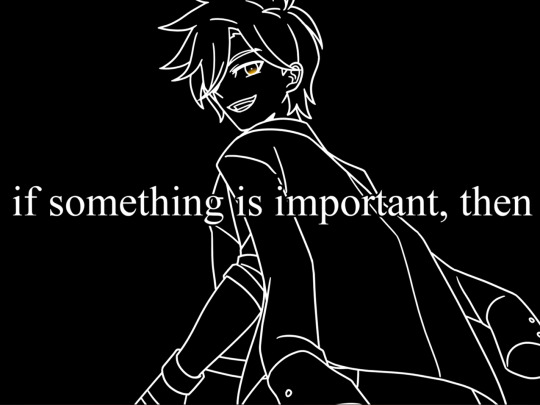

XVI translates to Hu from the crossword puzzle. He’s taunting her, similarly to how he did in the trial, although the ??? makes me wonder if it actually IS David…

XII, that’s Eden. I assume it’s because of her optimistic persona that she is standing in someone’s way, although we’re not sure who.

For the next part, let’s say we take this at face value. It could definitely be referencing David allegedly pushing Arei to commit suicide, although this could also be something he internalizes, with the themes of suicide and wishing to be dead explored previously.

These are all repeats of the previous works included in the MV, like The Little Prince, Ozamu Dazai’s series, Agatha Christie’s works, etc etc.
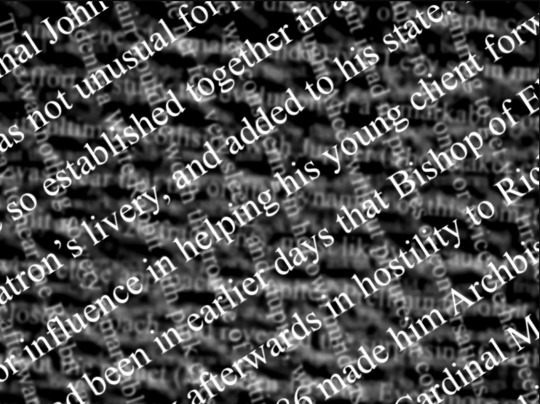
Now, this is code, I’m assuming, but I tried translating it and couldn’t find anything. It’s a common encryption language. In case you want to translate it, it’s:
3aqxw97pktc8uki458fbdpfoacllex2f07bf8mg24b4mpfx2adc6v3f5yhxjd8i7sf11312zaj5lazet47jod5jczec5mvb6bz2o59r143sf2pe916sczcn7emvbl55ehe9iqb2708tt83482c8tw3c77gn47ojca634gbcfz0016s647wwlakcn46brcle0eam9
NOTE: @glorywelpchild on Twitter says…
“For this, it may have been encrypted multiple times by different engines? I'm not a programmer so I'm not really familiar lmao. Another thing, it could be a type of programming the dev knows/commonly uses.”

The VI here is Arturo, but I don’t know what this means. Perhaps the description can give us some insight?

Hmm… Well, I don’t mind. Whatever you say.

Nico’s number is VIII, and this is referring to the defense they put up when asked about their intentions against Ace’s life. They claim they never thought about it, and “even if they try to think, they don’t know.”

This is Levi’s, as per the IX.

I actually managed to find the original image in the background. It’s a study on Comet Shoemaker-Levy 9’s orbit around Jupiter for several years before crashing into the planet. While the name, Shoemaker Levy, may be a play on Levi’s name, I believe this is also referencing that he may die soon. Maybe this is a stretch, but the symbolism of a comet named “Shoemaker Levy” crashing into Jupiter being right under a symbol that represents Levi, our prime suspect in a game where being caught results in death, is too far to be a coincidence. Part of my theory for Chapter 2 is that Levi is the blackened, after all, but that is in a previous post. Nonetheless, we can move on.

This is “Enterance of the Gladiators.” While it is now associated with silly things like clowns, it was originally a military march song. Hmm, where have I heard this description before?
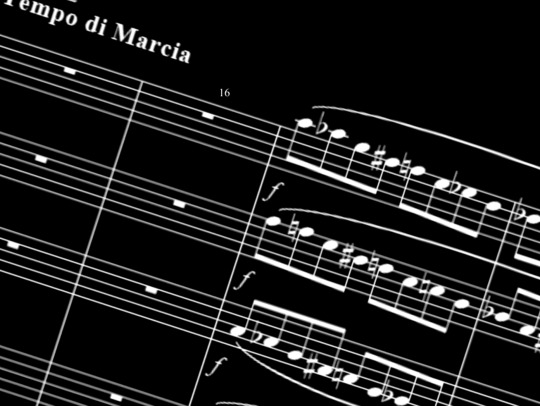
Ah, that’s right! In the description!

These two are relatively straightforward. The David we meet in the prologue is his facade, and it serves as an introduction. However, we are re-introduced to him with a whole personality change, and that comes delayed from all the others.
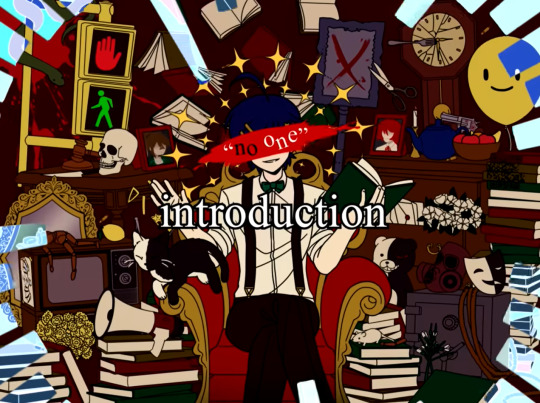

This is a direct reference to MonoTV and the throne in the trial room.

The truth bullets. Typical Danganronpa symbolism, and it’s also a neat little reference to Xander’s custom weapon.
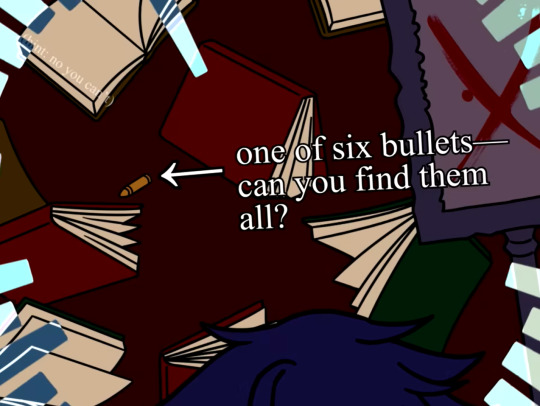
References to some of the students. The dresser is Levi, the bowl of fruit is Rose, the gun is Xander, the teapot is Hu, and the candle is maybe J?

The clock is Eden, the portrait, maybe a reference to the game? The stupid kid’s toy might be Whit.
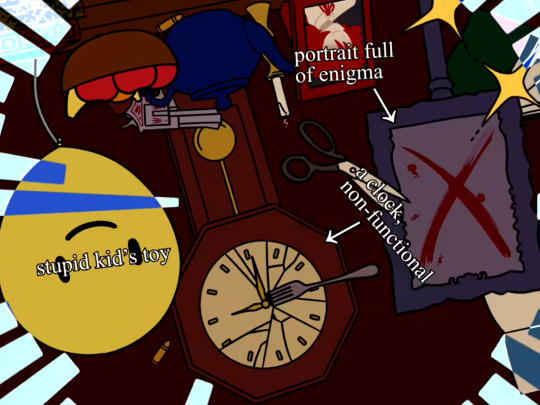
Teruko and Mai. Teruko’s misfortune and Mai’s idealization are both key parts of their characters.
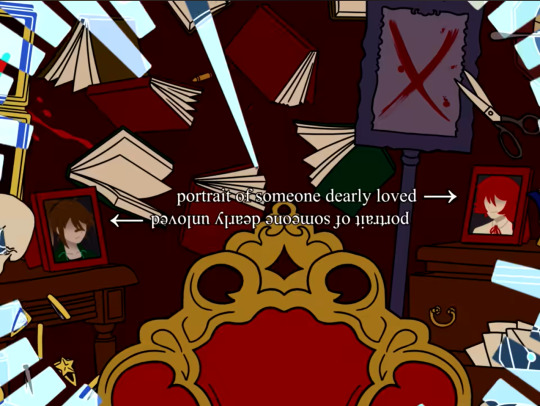
The gavel, another reference. The kitchen knife, Min. The skull, Veronika. The mirror… Possibly Xander because we’ve seen him with broken glass earlier in the MV, but it might be David and his personas making another reference.

The mastermind, sitting atop their comfortable chair.

The noose is Arei, the gas mask is Charles, the mouse is Nico, the theater mask… Perhaps the mastermind again, or Veronika again. The safe is David’s locked away and suppressed emotions. These are all mainly theories based on observation, don’t take it as the wholehearted truth.
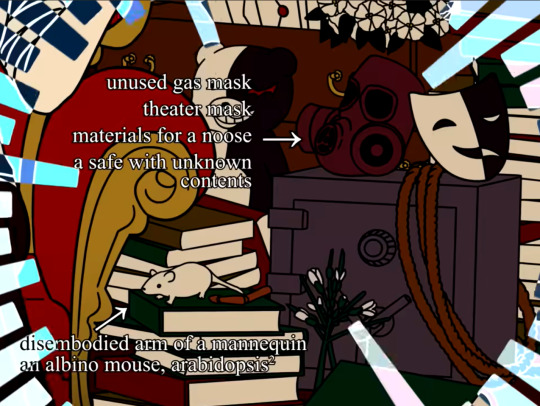
David being mentioned again with the hair clips. The lemon has been brought up beforehand, it’s a callback to the journal entry. The dummies represent David’s detachment from his humanity, and the television is a callback to the fact that they’re on a television show.

David views himself as a snake, a liar, a murderer. Snakes are common imagery to use when referring to the Devil as well. The blood is a callback to the killing game itself.
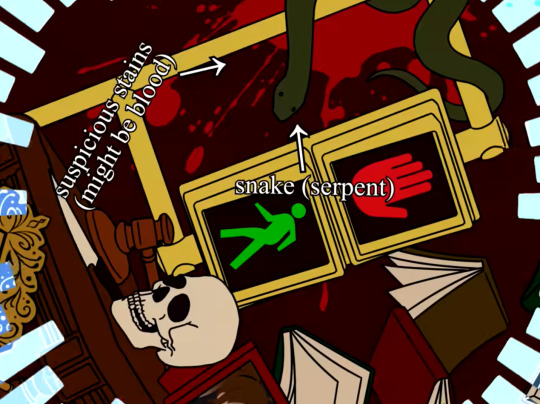
Either a reference to Min, or the fact that all the books are empty could be visual dramatization of David’s feelings. There’s supposed to be something in them, but the books are empty. The “various kinds” could also be how many personas he puts on, if that’s a prominent part of his backstory.
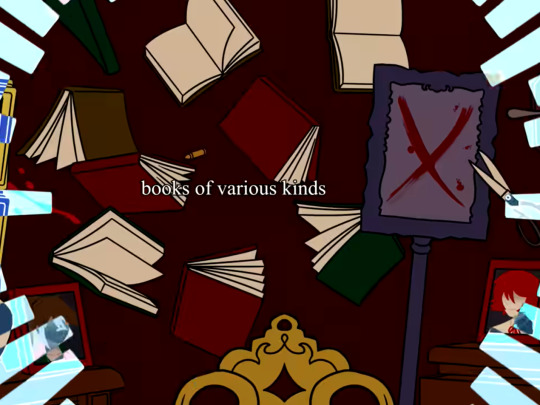
The killing game is being broadcasted, so that counts as terrorist iconography, if nothing else. Dandelions, while beautiful in their own way, don’t belong in a garden. The megaphone is David’s custom weapon, and it’s a way for him to broadcast his speeches to those around the world.
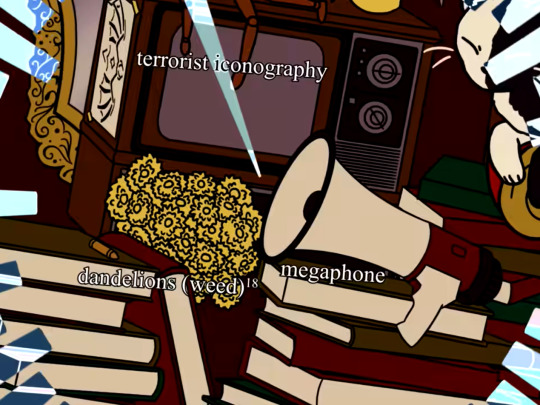
The letters are from the joke comic that the dev released. You know the one, where Xander writes a letter for David and he accidentally throws it away thinking that it’s garbage. The popular toy refers to the commercializing of the Tragedy, as Veronika explained on the first day of Chapter 2. How horror movies will put black-and-white designs in their films to up the fear factor because of the subliminal/primal fear of the design back in the days of the Tragedy. The flowers… No idea.

This is cleverly disguised, but it’s a reference to the debate between continuing to live and killing yourself. To be or not to be, to stop or to keep going, but they’re both lit up. How are you to do both at the same time? You have to make a choice.

Main Roles are David and Xander. It makes sense, considering they both have full-body moments and we know who they are. The crossed out name is Mai Akasaki, but the cut off name is a bit harder to decipher. Thanks to some inspiration and help, I’ve come to my final conclusion regarding this.

They are related to Arei, 100%. The letters match perfectly.

Even in comparison to Arei, the “N” in her name starts only a bit earlier, but that’s because the first word is probably only two or three letters, in comparison to the four letters in Arei.
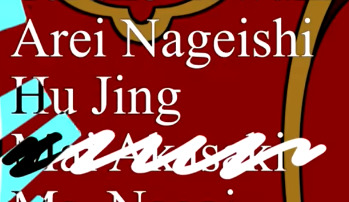
Originally, I couldn’t translate any of these. All I could make out was that the first hand was Xander and the second hand was Min or Mai. However. @MAHIRUMILGRAM on twitter managed to translate them! They are as follows:
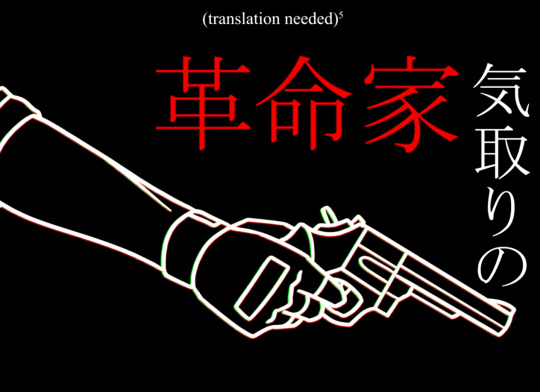
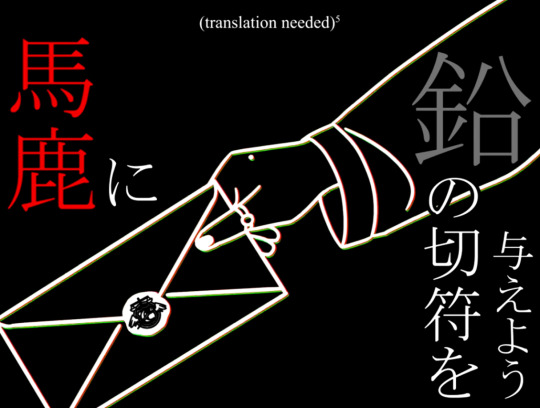







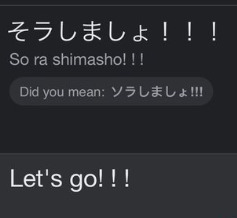
After this point, the truth bullet breaks through David’s words, similarly to how Teruko is fighting against David, despite the truth bullet being in agreement towards David’s idea.

There’s also this, which could be David trying to deflect us from the truth, or that the lyrics genuinely don’t relate to him. I’m leaning towards the former.

The white text at the top here is from a story, entitled “The Ones Who Walk Away from Omelas.” It is about a beautiful city where everyone is happy. However, their city is not as beautiful as it seems. They tell the story of how the townspeople have locked a child in a basement, and left it to suffer. Their happiness, as they’ve been told, requires a sacrifice.
“Inside the room, which is behind a locked door, there are a couple of dirty mops, a bucket, and a young child. The child is ten years old, but looks younger. The child is scared and completely miserable. It is never allowed to leave the room. Occasionally, someone opens the door and kicks the child to make it stand up. The person fills the food bowl halfway with corn meal and grease, fills the water jug, and leaves. The child can remember what the outside world looks like and begs and pleads to be let out. The child is naked and covered in sores, and it wails at night in its misery. The people of Omelas all know about the child in the basement. They all understand that everything good about Omelas, from their abundance of food to the good weather, depends upon the suffering of the child. They all understand this because when children are between the ages of eight and twelve, they are brought to see the child, and this tradeoff is explained to them. During this experience, the children of Omelas are disgusted. They want to help, but they are told they can’t. If anyone helps the child by clothing, feeding, or otherwise caring for it, then the perfect happiness of Omelas and its abundance would die. Therefore, no one may even speak kindly to the child.”
I wanted to include this because it describes David so well. Someone who has been cast away because they’re deemed useless to society, someone who’s happiness would destroy the happiness of anyone else. I find the story truly fascinating, as it might describe David’s suppressed emotions and the depressive tendencies he indulges himself in.
“Their tears at the bitter injustice dry when they begin to perceive the terrible justice of reality, and to accept it. Yet it is their tears and anger, the trying of their generosity and the acceptance of their helplessness, which are perhaps the true source of the splendor of their lives. Theirs is no vapid, irresponsible happiness. They know that they, like the child, are not free.”

“How you have felt, O men of Athens, at hearing the speeches of my accusers, I cannot tell; but I know that their persuasive words almost made me forget who I was—such was the effect of them; and yet they have hardly spoken a word of truth [alēthēs]. But many as their falsehoods were, there was one of them which quite amazed me—I mean when they told you to be upon your guard, and not to let yourselves be deceived by the force of my eloquence. They ought to have been ashamed of saying this, because they were sure to be detected as soon as I opened my lips and displayed my deficiency; they certainly did appear to be most shameless in saying this, unless by the force of eloquence they mean the force of truth [alēthēs]; for then I do indeed admit that I am eloquent. But in how different a way from theirs! Well, as I was saying, they have hardly uttered a word, or not more than a word, of truth [alēthēs]; but you shall hear from me the whole truth [alēthēs]: not, however, delivered after their manner, in a set oration duly ornamented with words and phrases.”
Do you remember, in the prologue, where Xander describes the “rumors” against David’s positive front? This is a direct parallel. Here, Socrates denounces the words of his attackers, similarly to how nobody truly believes the rumors except for the critics themselves. Even Xander was fooled by his charisma.
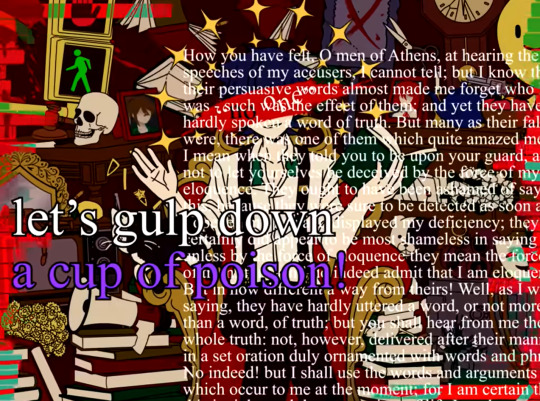
“Was't Hamlet wrong'd Laertes? Never Hamlet: If Hamlet from himself be ta'en away, And when he's not himself does wrong Laertes, 240 Then Hamlet does it not, Hamlet denies it. Who does it, then? His madness: if't be so, Hamlet is of the faction that is wrong'd; His madness is poor Hamlet's enemy.”
Hamlet blames his own insanity for the death of Laertes’ father. Just like David tries to get everyone killed, and blames himself for murdering Arei, because of his own insanity.

This is a line from the poem “Be Not Defeated by The Rain,” by Kenji Miyazawa. It describes a man wishing to become someone strong, someone who cannot be bested. I believe this is exactly what David wants, too. To be as strong and as hopeful as he is forced to pretend to be, instead of a hopeless mess who would rather die than be seen as worthless.

David reaches the height of his insanity, before finally quieting down after being basked in green light. I don’t know if this was intentional, but I believe that it represents how he’s given up on even death after the students manage to vote correctly, hence the green coloring.

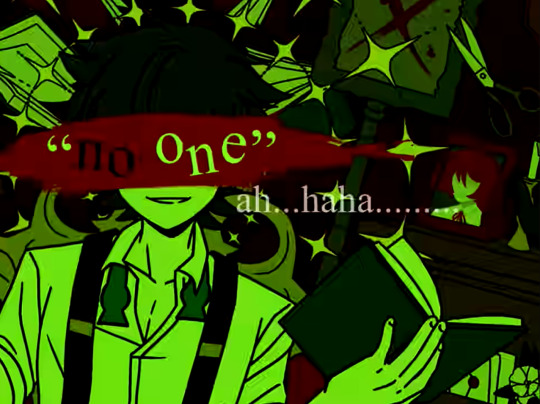
And now, number 19.

I severely doubt that David will actually die in Chapter 3. That is not “foreshadowing,” that is just giving out the answer, and DRDTDev is much more careful than that. I believe this is a final representation of David’s suicidal ideologies. He says he will forget, he says guilt will not weigh him down, but he’s lying to himself. That’s why the stars are still behind him, because he’s still lying. He says he is satisfied, he says he’s okay with death, but when has David ever been truthful with us?
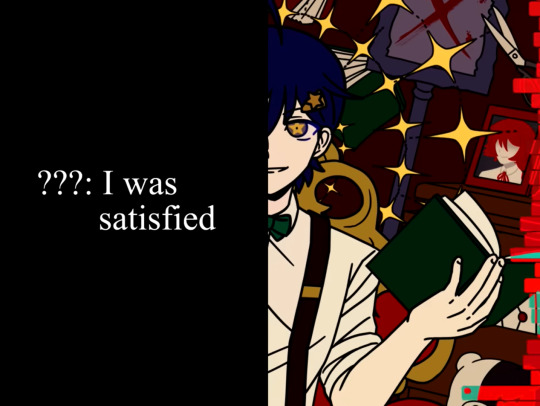
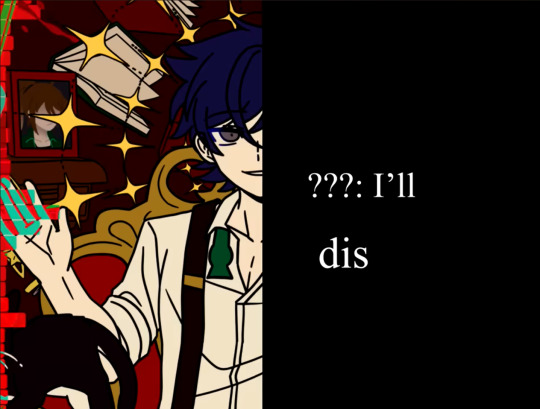

And he leaves an empty throne behind. Not because he is dead, but because he has relinquished his career and his reputation for nothing.
Even though he is missing, nothing else has changed. That is how he views his life.

And that concludes the main analysis of David’s MV! It’s such a beautiful thing, really, I don’t know how to phrase any of it properly. Thank you to everyone who’s read this far, and everyone who helped me out. The decoding and puzzles? Ah, I’ll let you all do that… But, maybe I can help a little!
Blanket, out~! See you all next time!
#danganronpa despair time#david chiem#dr#mv analysis#WOOH THAT TOOK ME 6 HOURS.#levi fontana#nico hakobyan#mai akasaki#ace markey#veronika grebenshchikova#eden tobisa#teruko tawaki#hu jing#arei nageishi#whit young#charles cuevas#rose lacroix
149 notes
·
View notes
Text
2024 Book Review #3 – Monstress Volume One: Awakening by Marjorie Liu and Sana Takeda
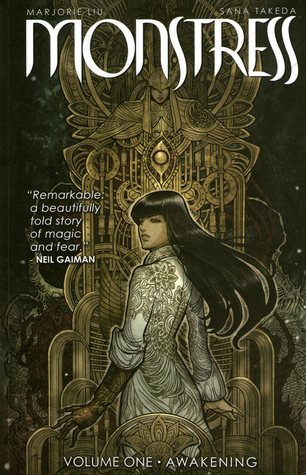
Monstress is one of about three comics I’ve ever considered myself an unequivocal fan of. I, alas, lost track of things during a hiatus a while back, and got to the point where I barely remembered where I was or what was happening. So, as a palate cleanser between longer books, I’m making it a project for the first chunk of the year to reread this from the start until I’m caught up again.
This is a very high concept series – a matriarchal dieselpunk fantasy world vaguely inspired by 1920s/30s East Asia with a strong art deco aesthetic. The world is divided between the Arcanic Courts – kingdoms ruled by the animalistic ‘Ancients’ and populated by the Arcanic descendants of their half-human children – and the Federation – a human nation-state dominated by witch-nuns who derive their influence from being able to render down the corpses of said Arcanics into magically potent ‘lilium’. Also there are insubstantial projections/ghosts of titanic tentacle-ey monsters that wander across the landscape sometimes. And a genocidal war ended in a stalemate a decade ago after a city was destroyed by something that no one on either side understands. Oh an in addition to the anthromorphic animal Ancients there’s also just normal cats, except they’re sapient and capable of speech and also necromancy. The book really throws you into things and a decent chunk of the first volume is just introducing and establishing the rules of the world.
The actual plot follows Maika Halfwold, an Arcanic who can pass for human except for the giant occult tattoo on her chest. The story follows her abandoning her girlfriend and voluntarily getting herself enslaved and brought to the mansion/mad science laboratory of a powerful witch-nun so she can break out, fight her way through it, and interrogate her at gunpoint for information about the giant gaps in her memory of when as a child her mother worked with the witch on an archaeological dig. Things escalate from there due to a shard of an enchanted mask and an eldritch abomination that had been slumbering with Maika’s body who is awoken by it. The balance of the volume is spent with her, an incredibly untrustworthy cat, and a vulpine arcanic child who she more or less accidentally rescued from slavery as they try to escape the manhunt after them.
So there’s a lot here, and I really do love almost all of it. Most obviously, the art is just gorgeous – I mean, I’m an easy sell on dieselpunk/fantasy 20s stuff, but genre trappings aside the detail and use of colour is just incredible, and even the less detailed panels do an amazing job capturing expressions and emotion. Basically every aspect of character and environmental design is just very deliberate as well – aesthetics reflect character, and scenes are full of little background details that help sell and fill in the world. But fundamentally just very pretty, an aesthetic pleasure to behold.
Of course, one of the things a whole page of artistic flourishing is devoted to is a flashback of Maika – a starving enslaved orphan during the war – eating the stomach of another child who’d died before her to keep herself going. This is a book that just about exults in brutality and brokenness – ‘there is more hunger in the world than love’ is basically the tagline of the entire volume. This is a world on the verge of a genocidal total war, rife with slavery and human sacrifice, and it pulls absolutely no punches about depicting that (so, so many dead children). With, like, one-three exceptions everyone is flawed and compromised and betrays something they care about when their backs are against the wall. You really and truly can’t trust anyone.
You can see this clearly with Maika herself. She’s just, genuinely an incredibly unpleasant person to be around. Responds to feeling unsure or anxious by lashing out, all but incapable of showing affection in any legible way, too wrapped up in her own mountains of bullshit to even notice what anyone around her has going on until it’s shoved right in her face, paranoid and suspicious and more comfortable with violence than uncertainty, has 100% gotten people killed multiple times due to lack of ability to get over her own (mountains, abyssal, soul-crushing) trauma – really the list just goes on. In her defence basically everyone is actually out to get her (sadly the paranoia and suspicion do not in any way actually make her more difficult to deceive or betray). Anyway, I obviously love her, and the supporting cast is very nearly as good.
Just, generally this is not a series where suffering is ennobling – fear and shame and trauma and a desperate need to cling onto what power or privilege you can drive people as much or more as sympathy for or solidarity with others going through the same things they have. The fact that the Federation is run by a bunch of genocidal religious fanatics doesn’t mean the Ancients ruling the Arcanic Courts are good, or even necessarily that they care about the lives of their subjects beyond their own power and pleasure. It could easily tip over the edge into monochrome nihilism, but it actually manages to toe the line very well.
Though like, despite everything I just said, it does do the oddly common modern genre fic thing where there’s brutal unsparing depictions of colonial plunder and oppression but also everyone’s an intersectional feminist. Not as much as some, but the race-war is between humans and arcanics with no one seeming to care on whit about intraspecies ethnicity or race, and the setting is matriarchal in the modern implicit glass ceiling way a modern American corporation is patriarchal, not the way a midcentury warlord state or fascist empire is patriarchal (not that this means there aren’t graphic threats of rape or depictions of what’s clearly sex slavery just that being the one holding the lash isn’t really gendered).
So yeah, overall happy to report that the first volume of this still absolutely and entirely holds up – and considered as a work on its own the first volume really coheres far better than I’d realized when I was first reading this in one mad rush. Very much looking forward to continuing on to volume 2.
58 notes
·
View notes
Text
“Genshin character designs are bad.”
You really can’t navigate through the Genshin fandom without hearing this take. It’s stale at this point, but it’s…. also true. Except that’s usually not what people are actually saying. The true question up for debate: Are Genshin character designs ugly?
It irks me because there is validity to the original statement, and yet the conversation immediately moves into the territory of strictly opinion, leaving the true discussion never to be had.
So I’m having it… with myself…. in the form of a long post, because actually I find Genshin an interesting character design case study.
Before I really get into it I must address the elephant in the room; are Genshin’s character designs colorist?
Yes. Moving on.
Okay, okay, I’ll address it a little, Genshin has a problem with colorism. It’s a fiercely debated topic and honestly it’s one of the only real valid discussions I see around Genshin’s designs. That being said, I have nothing new to add to the conversation. If you don’t know why, sorry I’m not qualified to answer that, but you’re in luck because tons of qualified people have explained it across all platforms.
What I am partially equipped to talk about is character design. I’m no expert but I have taken a few formal classes on the subject, so I do have some insight to share. Character design at its core is usually quantified by how much of a character’s personality can be clearly determined from sight alone and how recognizable their silhouette is (though I’m not gonna touch on that today). Now there’s a lot of factors that go into both, but the fundamental thing that contributes to both is something known as shape language.
Shape has meaning. What that meaning is often depends on culture factors that determine your associations, but the Western simplification of shape is that circles are good-natured, rectangles/ squares are reliable, and triangles are energized. (these are my own personal words for them, there are countless ways to go about describing these associations) Shapes are then combined with each other to create more complex associations, and so on and so forth. It’s impossible to create a character without evoking some form of shape language, because art at its core is just shapes. The classic example are the round shapes seen in Mickey Mouse, though often times it’s far more subtle, like how Barbie has soft, round lines in her hair and face, but her hourglass figure is comprised of triangles to tell you she’s sexy, but the soft curves say she’s sweet not sexual— and it quickly gets very complicated. Basically character designs are rarely comprised of one shape alone, and when combined the “vibes” they evoke become complex.
So what does this have to do with Genshin? Genshin has poor shape language. The most obvious example of this are the faces. Genshin has same face syndrome, which I partially contribute to budget constraints with the models seeing as they reuse them over and over. Though it also has a lot to do with Genshin’s need for their characters to be conventionally attractive. Everyone must be beautiful and, as the current trend in anime artstyles dictates, not look a day over 12. The only thing that changes is the eye shape, but even then, it really doesn’t. There’s diversity between the male and female models, but calling it diversity seems generous, because they are practically the same. All the viewer has to go on to differentiate between faces are the expressions (and color but we’ll get there), which are also limited by the models.
The poor quality of the shape language continues into the bodies, seeing as the only thing that really changes is the height, not a lot of room for show casing contrast. (Also body diversity is just a good thing to have for the sake of having body diversity.) Visual contrast is one of the key things good shape language should deliver. It’s within this contrast that the viewer will have the opportunity to compare and thus make these associations. One character design may tell you things based on previous knowledge but it’s like an experiment without a control group.
Then we get to the character’s outfits and hairstyles. While it’s true there is a fair amount of diversity in clothing, the shape language continues to falter. Genshin characters have so much going on constantly in their designs that it seems like that should provide plenty of opportunities to showcase personality. Unfortunately what ultimately happens is that the details compete amongst themselves so much that they overshadow any sort of unified message they might have had about who this character is. Basically there’s too many different shapes. They don’t create a pattern and therefore don’t form any strong associations. You can have a good design with a lot of details but they should communicate a pattern together. A design is not good simply because it has a lot of detail. I will say there are definitely times where the clothing and hair do actually come through to tell me stuff about the character, but overall this over designing tends to be a detriment.
Genshin’s hair while in different styles usually relies on the same type of pointy strands and blunt edges.
(these characters were randomly selected to prove my point that you can quite literally pick any character in genshin and they will have at least one of these two components)
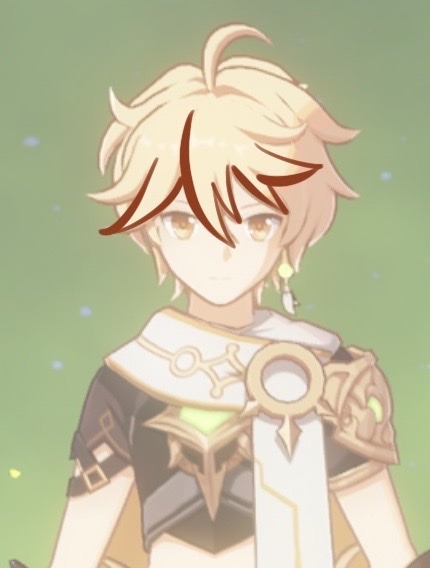

On their own pointy strands might tell us something, but considering every character has them, the pattern within a single character is rendered moot. “If everyone’s super, no one is.” Of course how they choose to wear their hair does speak to the character but its effect is limited when the structure of the hair is fundamentally the same. And then when you consider that the styling of many of these hairstyles doesn’t actually say a whole lot, it becomes obvious that Genshin is more concerned with creating hair that stands out. The problem is that details, asymmetry for example, normally tell us about the character, but considering so many hairstyles utilize asymmetry, it looses its meaning. Overall I will say I think Genshin is more of a 50/50 toss up on whether or not the hair suits the character.
I want to take a moment to point out a couple hair style designs in Genshin I think are really lovely and work very well.

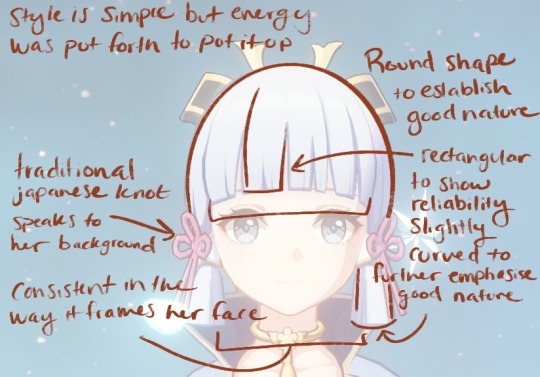
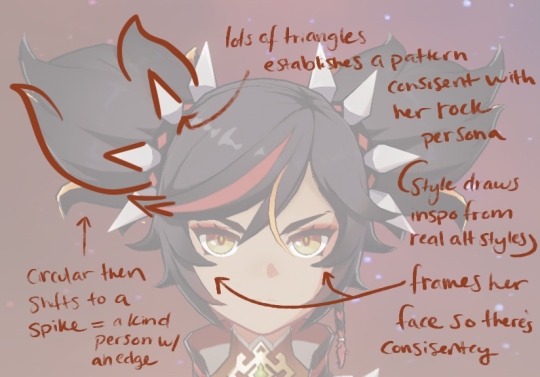

And now I would like to do the same with some outfits.
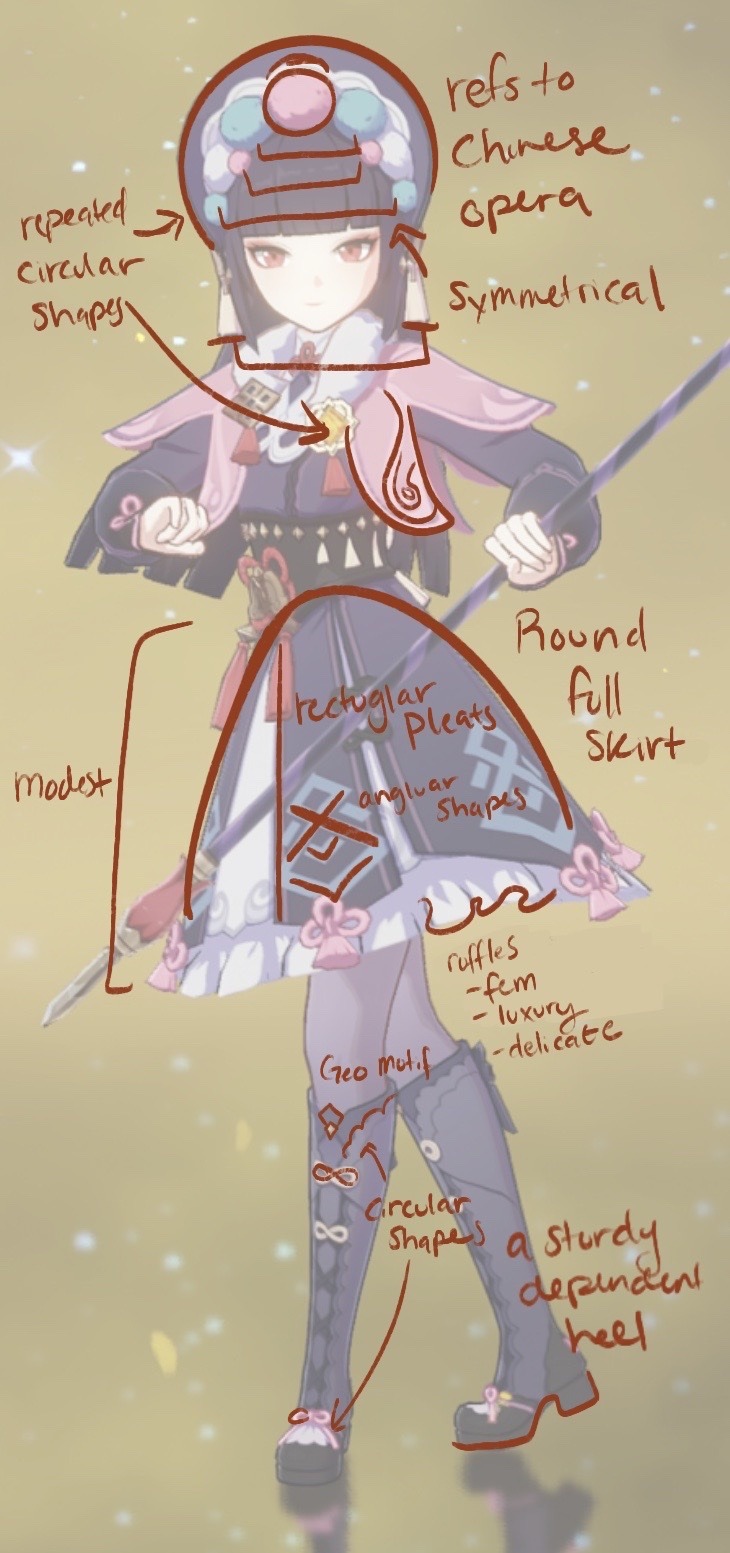
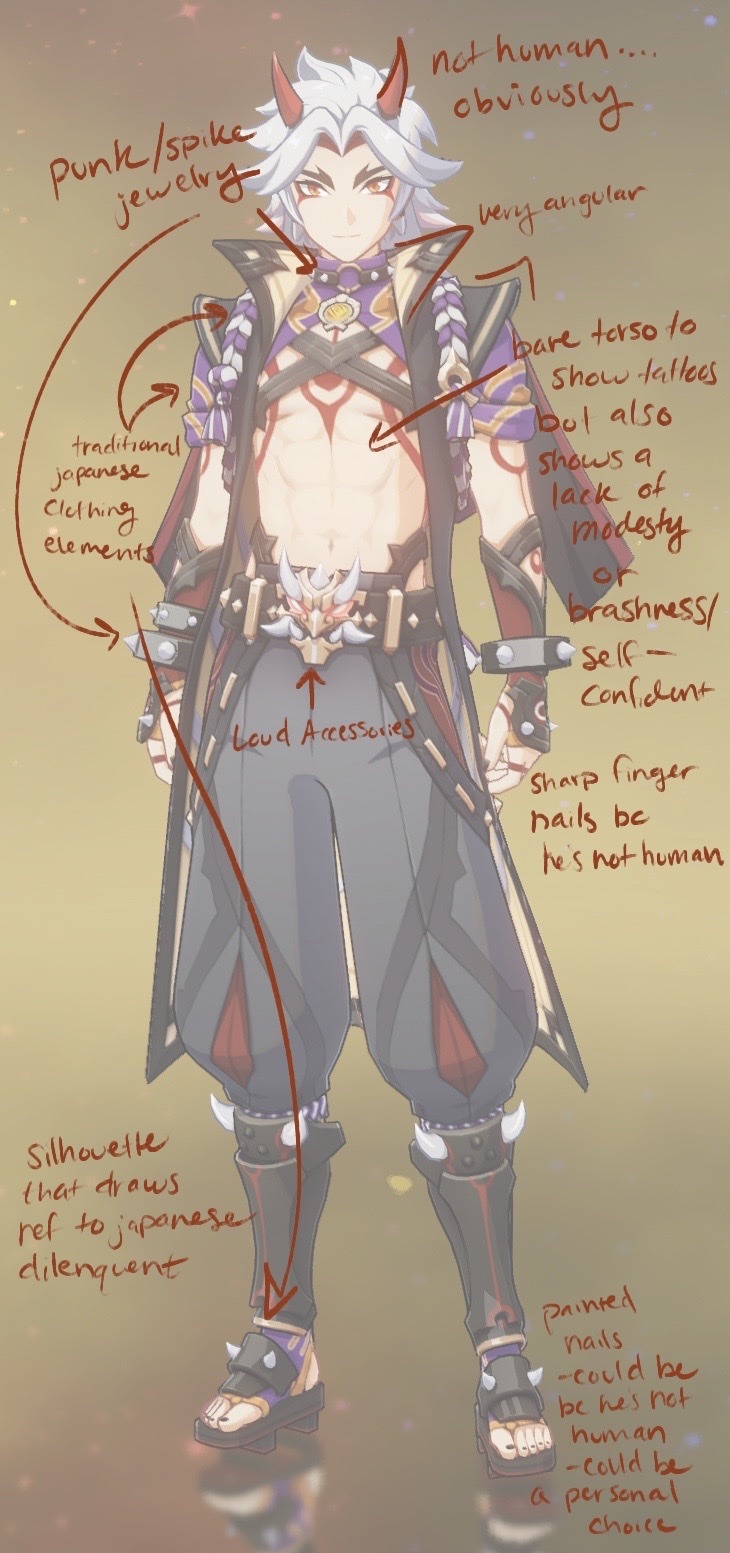

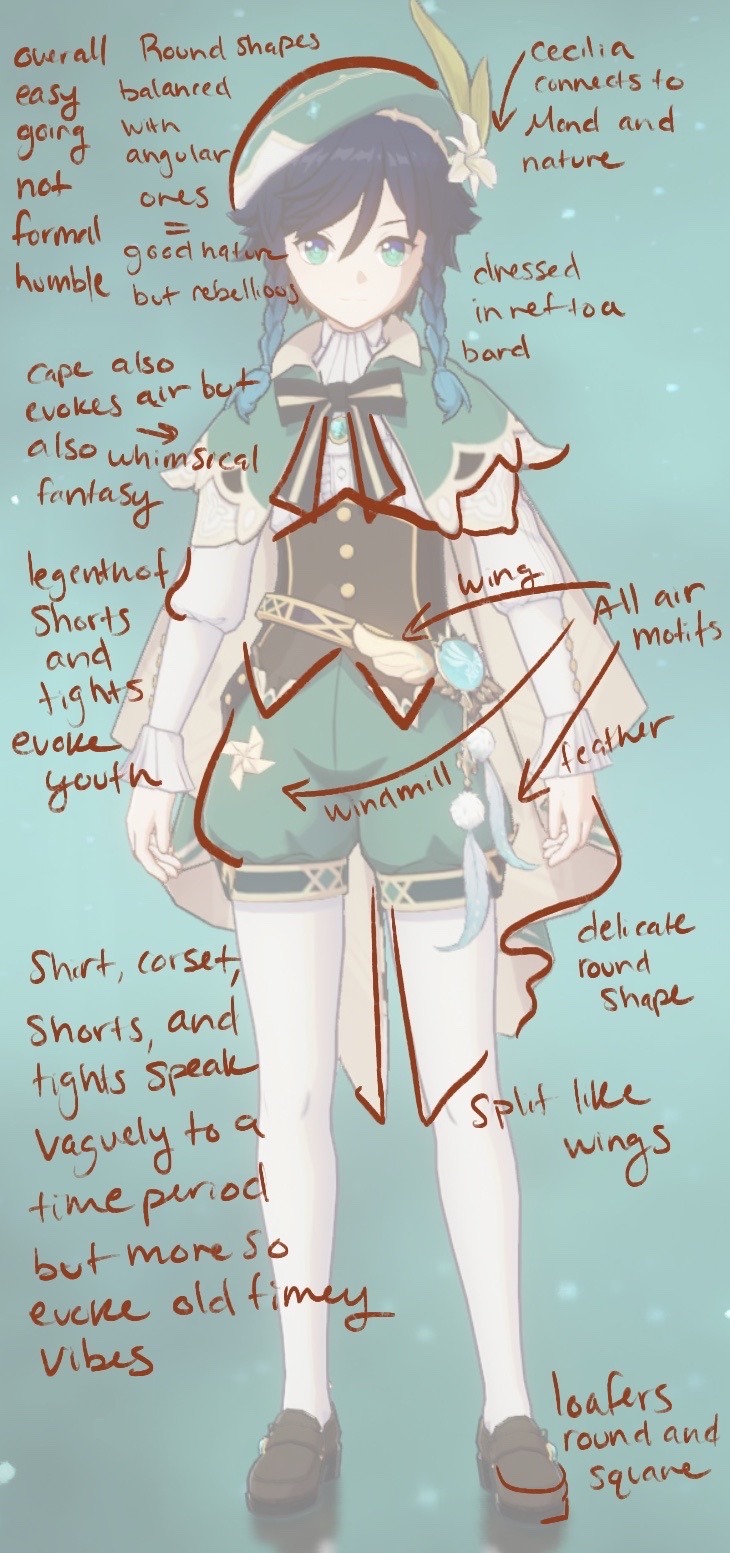
(honorable mention to Bennett for being over accessorized in a way that actually tells you about his personality (goggles, a scar, bandaids, work gloves, utility belt), to Barbara for somehow mashing the concept of a nun and an idol together, to Klee for her childish whimsy and finally to Scaramoche for the sheer amount of subtle character growth motifs fit into all three of his outfits (the cultural stuff is really cool too))
Genshin I will say does a great job of creating and repeatedly using the elemental imagery as well as Khaneira’ah’s star. I also appreciate that every Archon has that ombre hair shift that glows during their burst. Makes them feel unique.
I think Genshin shines the brightest when they successfully incorporate cultural elements into their designs however, the only nation that does this with any sort of consistency is Inazuma. Inazuma’s aesthetic is so instantly recognizable. No one dresses exactly the same, but there are common through lines in the shoes, the style of the armor, and patterns in the clothes. (The design aesthetic is so strong that even after Scara got a Sumeru makeover he managed to keep elements that were clearly identifiable as Inazuman) Every other nation falls short in this department. I will give credit to the knights as there is some level of consistency in their designs, mostly in the metallic detailing; not quite a uniform but there is some commonality. Liyue does have cultural influence that definitely shows but it suffers from an overall lack of consistency in aesthetic, and doesn’t lean into its Chinese inspiration the same way Inazuma does. Mondstadt on the other hand is just vaguely European, but also half the time not even.
And then there’s Sumeru. I distinctly remember looking at the full Sumeru cast the first time and thinking that none of the them looked like they came from the same place. (It’s almost as if Sumeru is based on a bunch of separate countries that are culturally very different.) Pretty much no character has any real ties to any any real culture, but instead they just sorta grab vague elements. And at its worse just leans into orientalism (Nilou and Dori). I think personality wise the designs do a fairly stable job of saying at least something about their characters (Dehya and Kaveh). The designs do well individually but between the vague references and inconsistencies they falter. (I will say Cyno’s whole design being a reference to Yu-Gi-Oh is both hilarious, charming, and also mildly appropriative.)
On the topic of appropriation I think it’s important to note that Inazuma suffers from this too. While I absolutely love the way a lot of Japanese elements were integrated, outfits like Yae Miko’s shrine maiden garb bring forth this sexualization of cultural dress that I’m not particularly fond of. But then again you can also critique Rosaria’s sexy nun design for the same thing.
I also want to touch on something briefly because it’s important to note, but it’s a separate, much bigger conversation; Genshin, like anime, falls into a trap of catering their style to lolicon and shotacon enjoyers. It’s the reason all the characters look so young, why all the age discourse exists, why they refuse to confirm ages, and why all the children with the toddler model have some weird age work around. I don’t like it. It’s gross.
Another brief mention because it’s its own conversation; the female characters in Genshin are often over sexualized. Their clothes are skin tight, they almost always have weird random cut-outs, their skirts and dresses are designed to show off their breasts and asses, and all of their designs are high fem regardless of their personality. Give a female character baggy pants Genshin I dare you. Dori doesn’t count, she’s a toddler model in just a bra. I don’t have a problem with a female character being hot, but when that’s the only requirement…. it’s tiring. The classic female character design video game debate…. yah.
I think my overarching issue with Genshin’s clothing design is it says nothing about whose these people are. What jobs do they do? What do these accessories say about them personally? Take Yanfei. She’s a lawyer, yet nothing about her outfit speaks to that in the slightest. I remember the first time I sat down and looked at all the playable characters with a friend of mine. I didn’t play at the time and we thought it would be fun to see if I could guess their personalities. As you can imagine I did pretty poorly, and that’s because these designs just don’t suggest a whole lot.
And then we get to color.
Color is probably the most complicated part of art let alone character design. I feel as though we all have some familiarity with the concept of color coding in character design. The classic red/blue character foils. Color often suggests specific traits similar to the way shape language does, except unlike shape language color coding doesn’t always apply. You can’t just assign a character a color and call it coding, the character has to physically have that color on them in some significant manner. For example Naruto is clearly an orange coded character. He appears in the color throughout the series, but I couldn’t classify Eren Yeager as a green coded character even if it suited his personality (which it doesn’t) because it’s a uniform everyone wears. Attack on Titan does not evoke color coding the way Naruto does, so it’s not applicable.
With Genshin color is complicated. Genshin does have an established color pattern for all the elements, but not every character wears the color of their element. Now normally I would say just having a color pattern for the elements wouldn’t be enough to justify character color coding (since it would fall back into the uniform category), but in Genshin their visions connect to their personalities, so therefore the color of the elements is connected to them. For some the color coding is very obvious (Kaeya & Diluc) and for others it’s practically nonexistent (Yun Jin & Heizou). In all honestly I don’t know what to make of this other than Genshin is inconsistent in their elemental color coding but always consistent in their high saturation. Because color is complicated and a weaker area of mine it is equally likely that I’m missing something or that Genshin isn’t coding anything and it’s all pure aesthetics.
Which brings me to my final point; aesthetics. Hoyo as a company cares that you spend money. That is the number one goal at the end of the day. That’s why all their characters are conventionally attractive, why their art style is the way it is, why their shape language suffers, and why their outfits are overly detailed. It’s all about aesthetics. As a brand Genshin cares less about their story and more about how pretty their characters look, because if their characters are pretty then you’ll spend money. It’s not like Hoyo designed characters with bad shape language because they were ignorant. They knew exactly what they were doing when they sculpted every last visually pleasing strand of pointy hair.
Which brings me back to the real question that people were actually arguing over in the first place; are Genshin characters ugly?
I can’t answer that question. I mean they weren’t designed to be ugly, but if they don’t appeal to your taste, then to you they are ugly. But it’s more important to understand that “bad” and “ugly” are not the same. Genshin character designs are bad by professional standards but that doesn’t mean you can’t like them. Genshin designs can be both bad and likable, bad and pretty, bad and cute. Those are two vastly different things. It’s the same way people adore cult classic movies. They’re not good in the eyes of a critic, otherwise they wouldn’t be niche. They’re cult classics because people like them. Personal taste is just that. Personal.
But the most important question of all; do I like the Genshin Impact character designs?
I didn’t use to but I gotta say, they’ve grown on me.
#genshin#genshin impact#long post#it’s an essay#i wrote an essay#character design#tagging the characters i look at specifically#in a positive light#yoimiya#venti#ayaka#zhongli#itto#yun jin#xin yan#tighnari#sorry about any potential typos#i have no beta reader#so it’s just me and my notoriously bad reputation for not spotting mistakes
98 notes
·
View notes